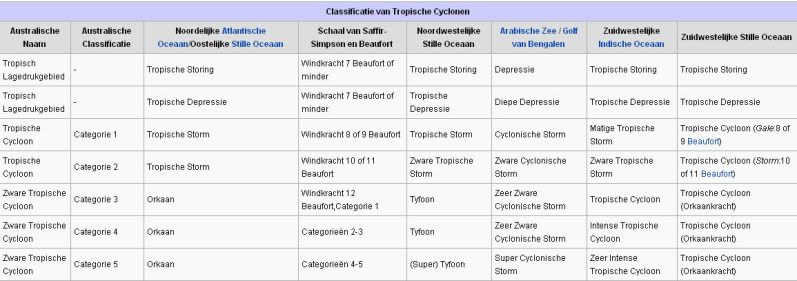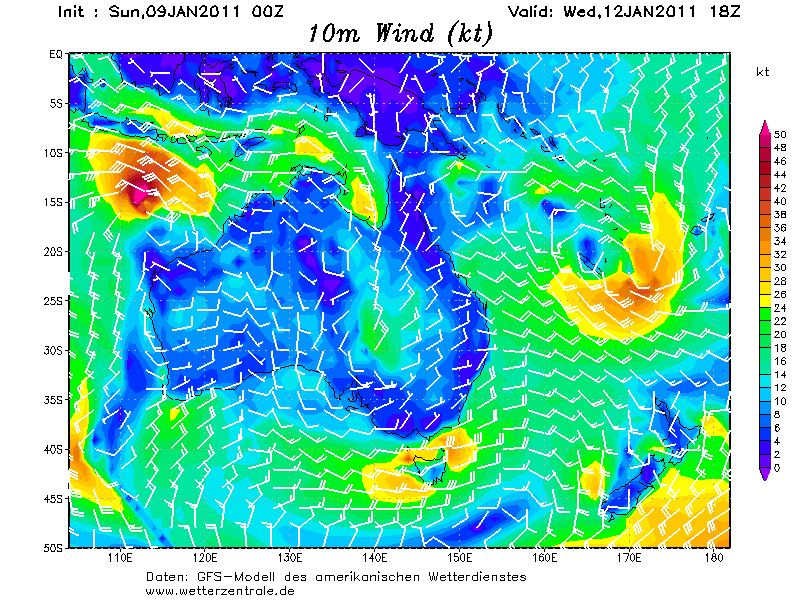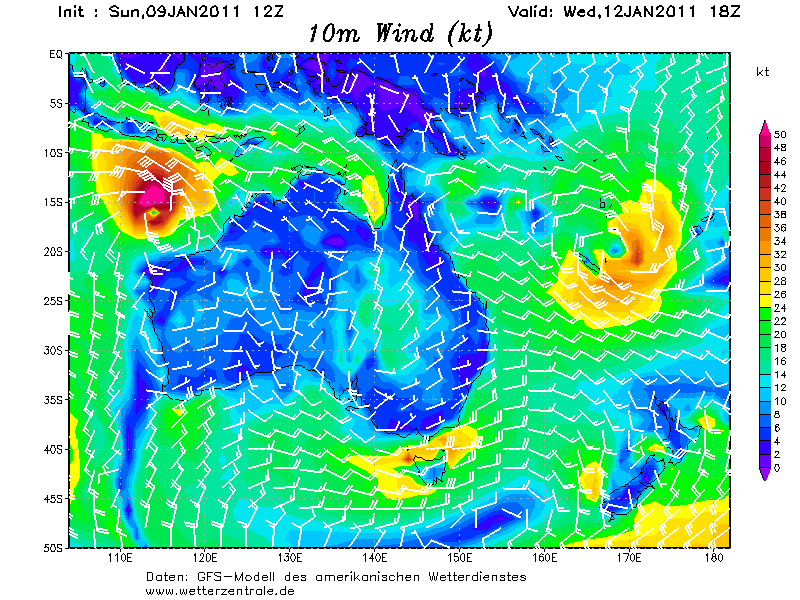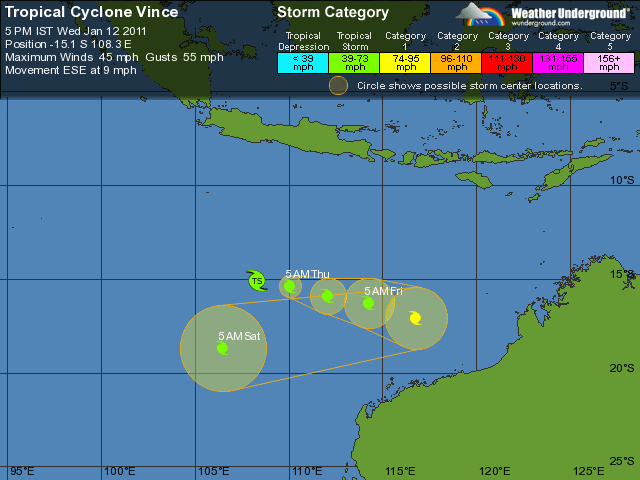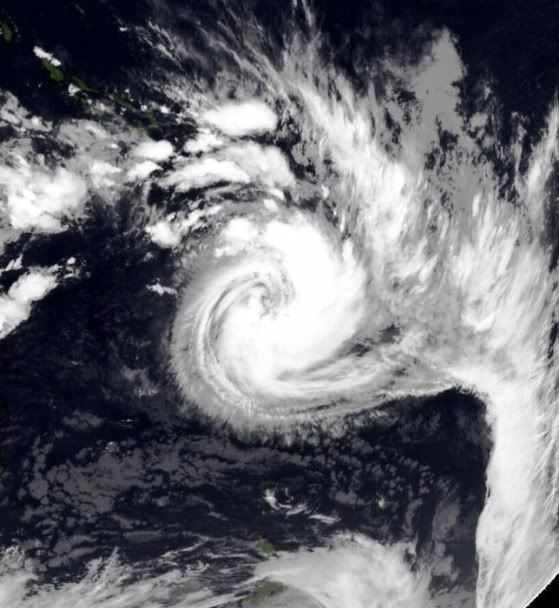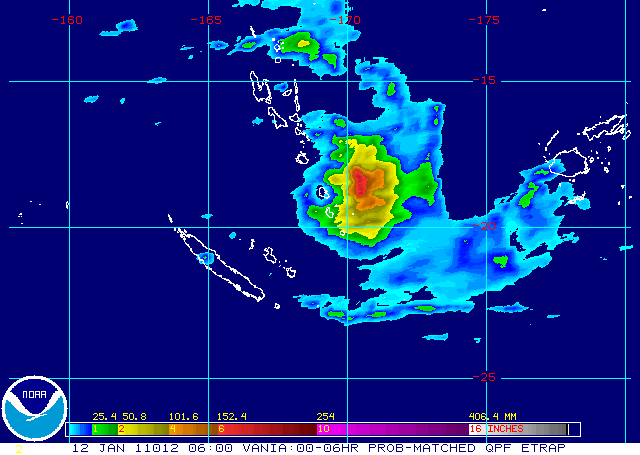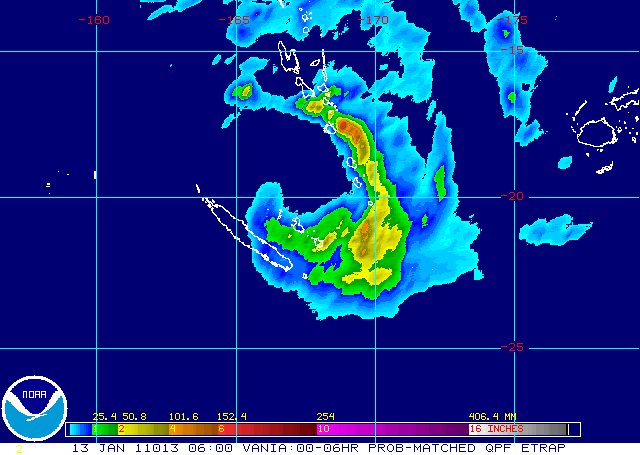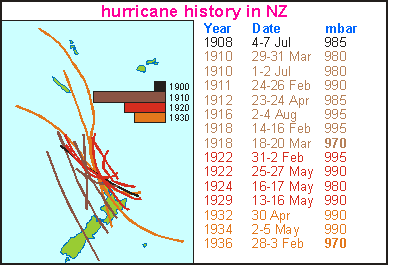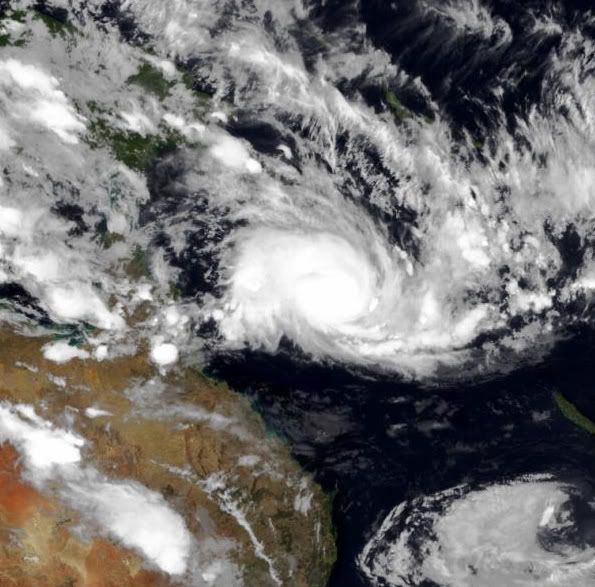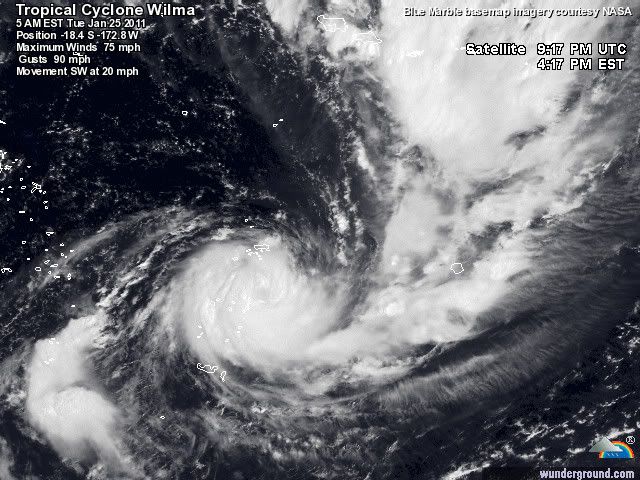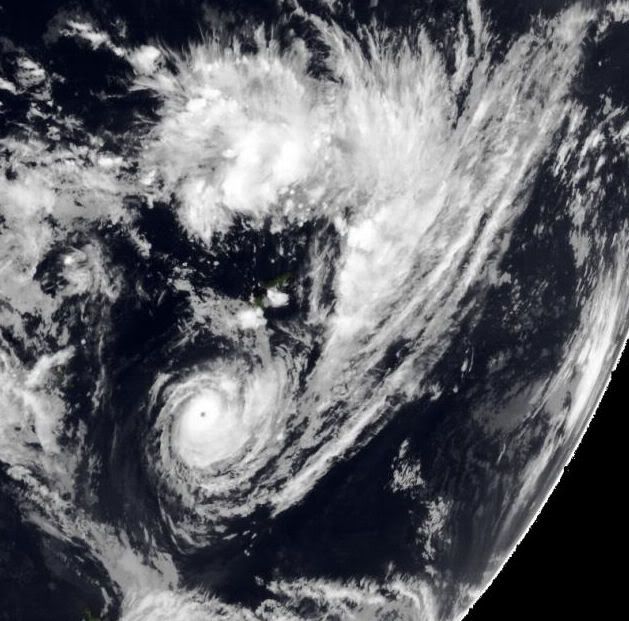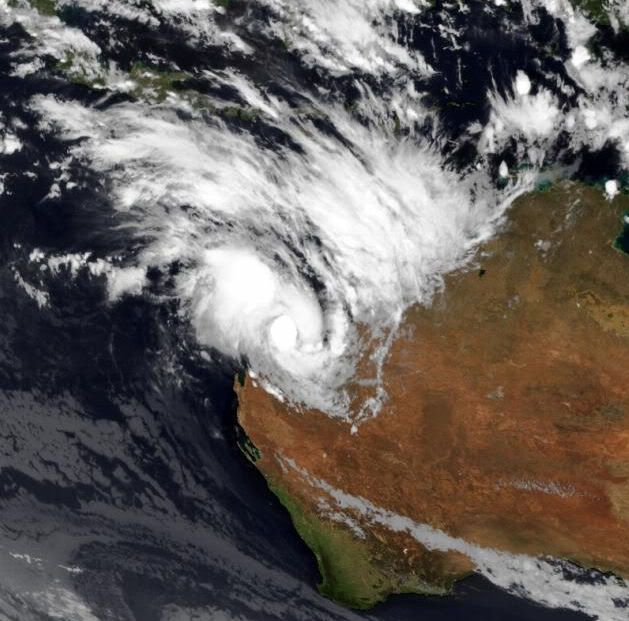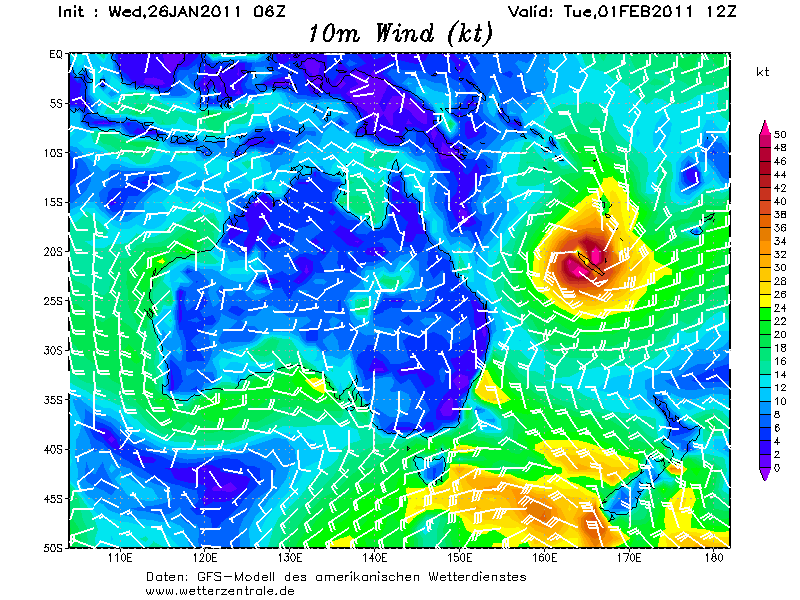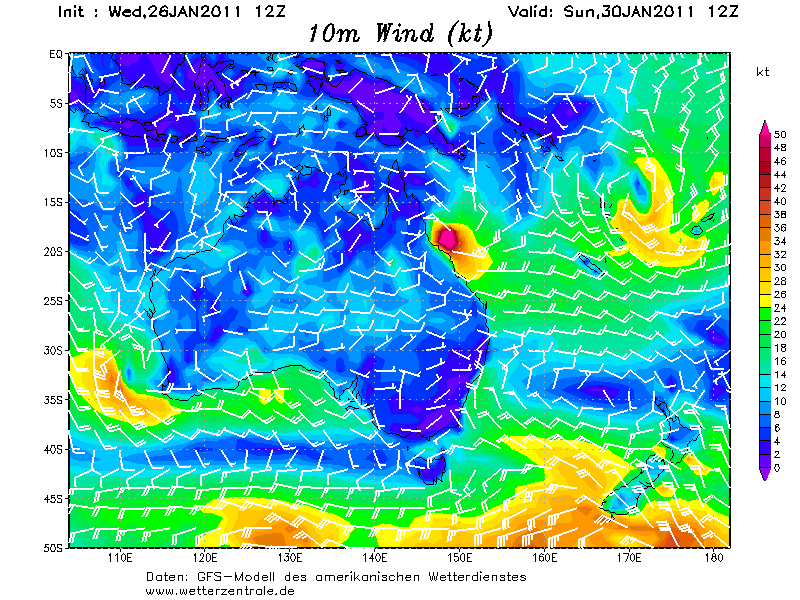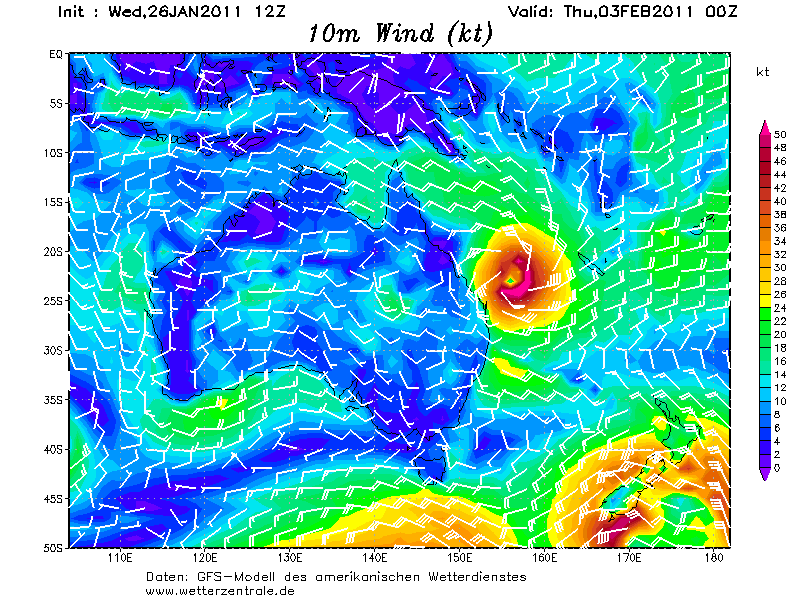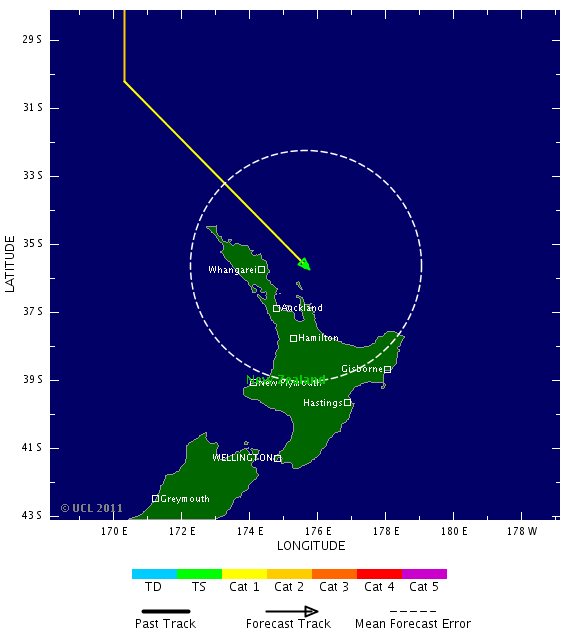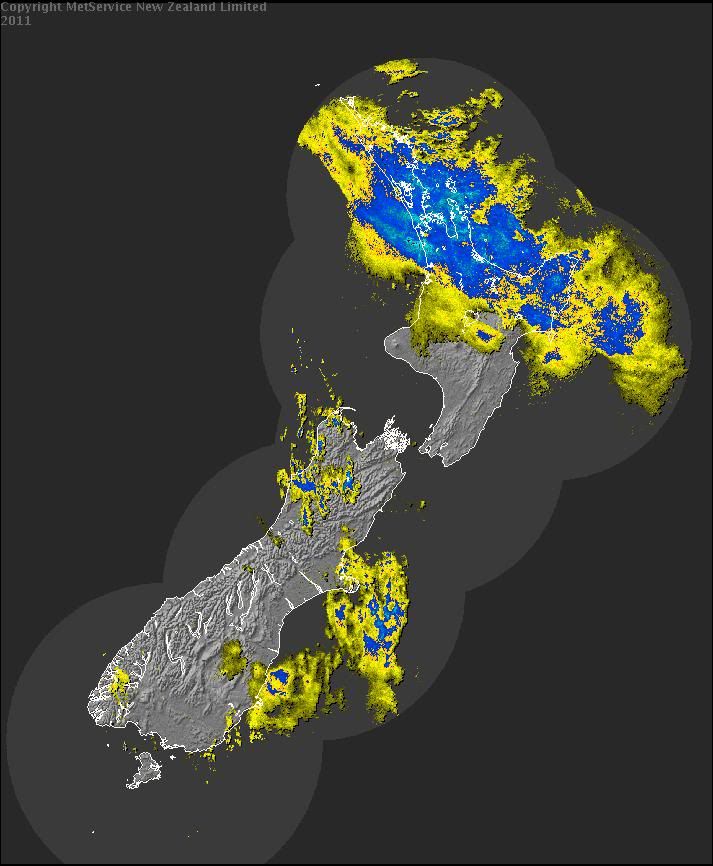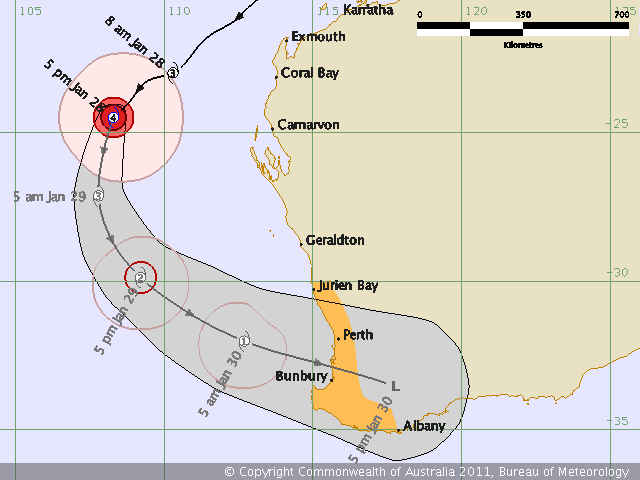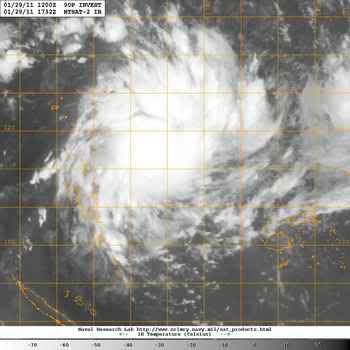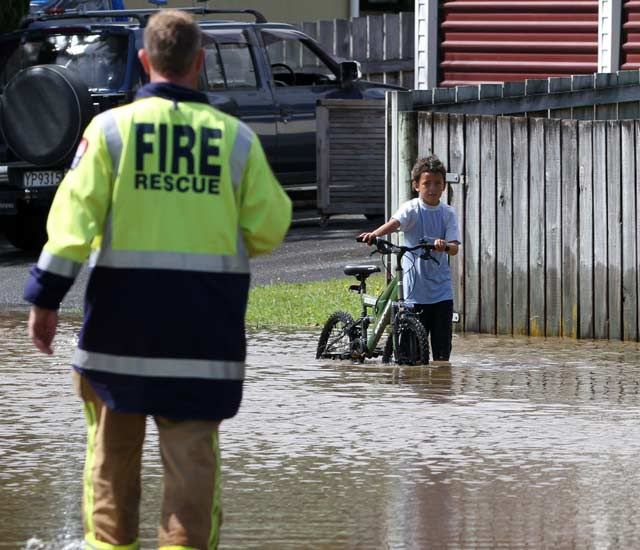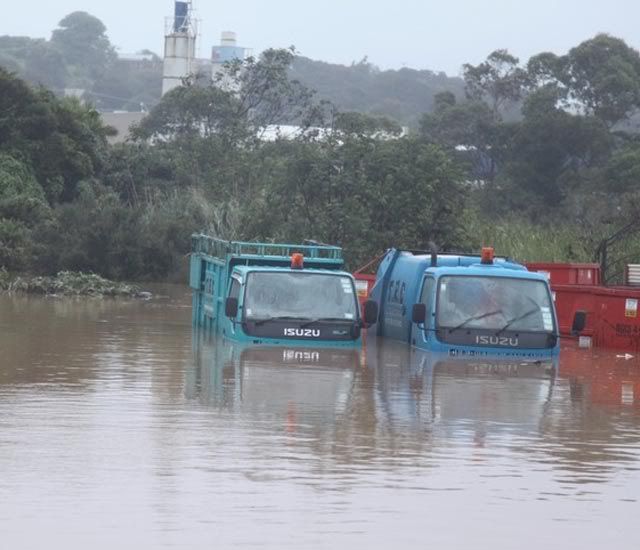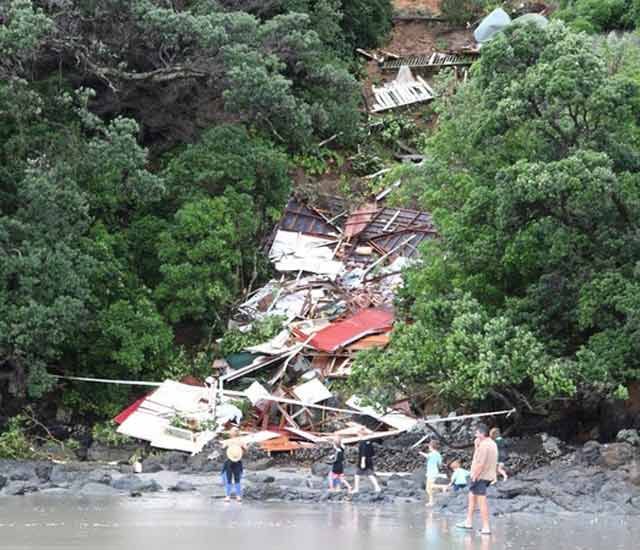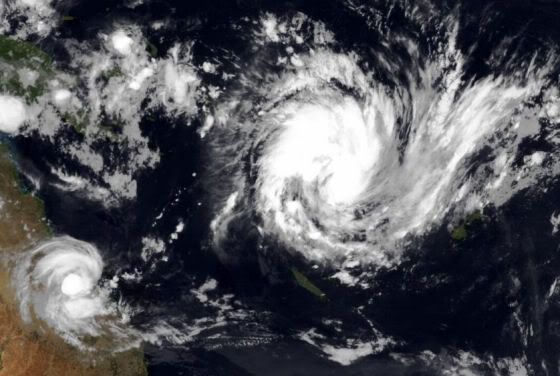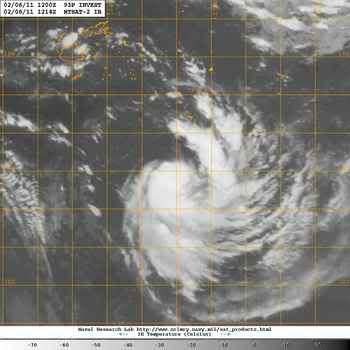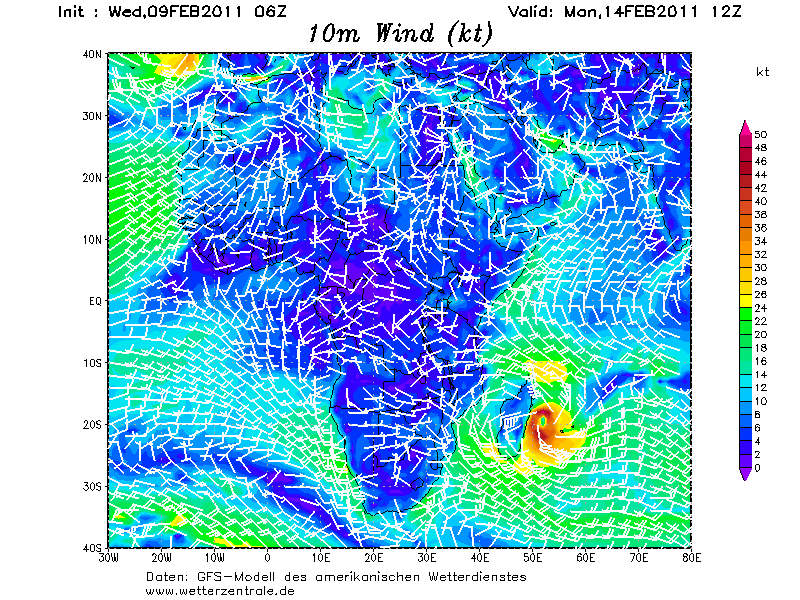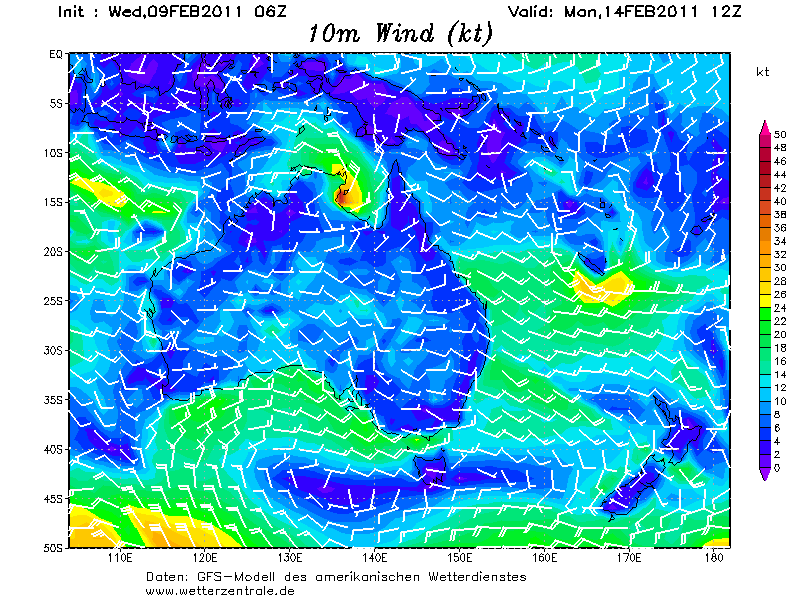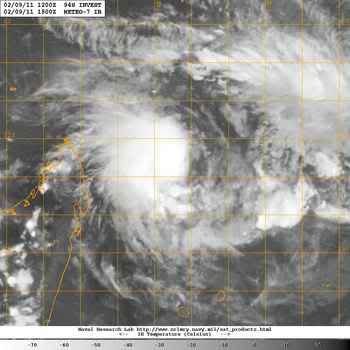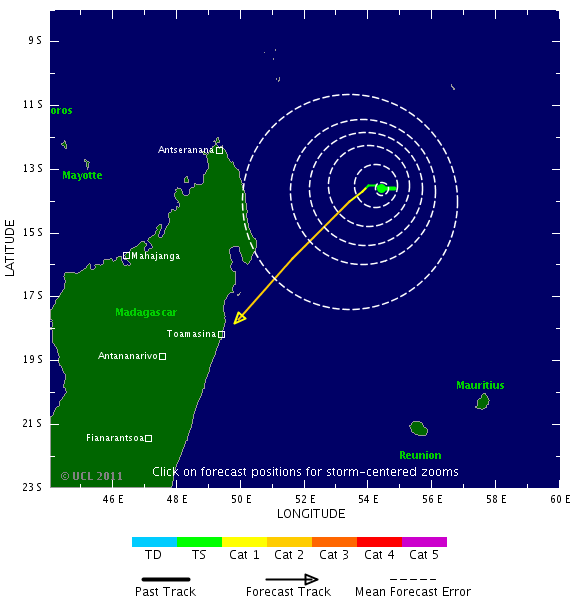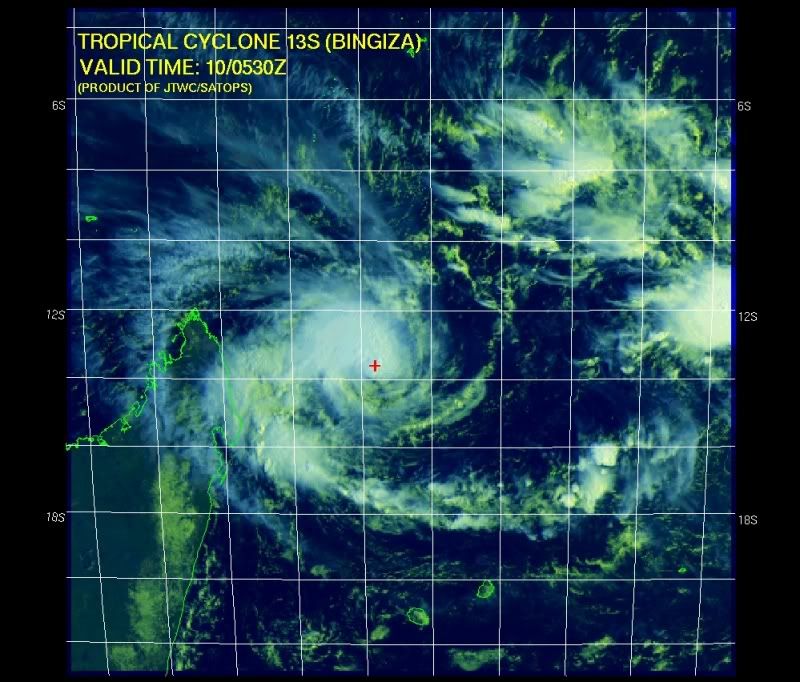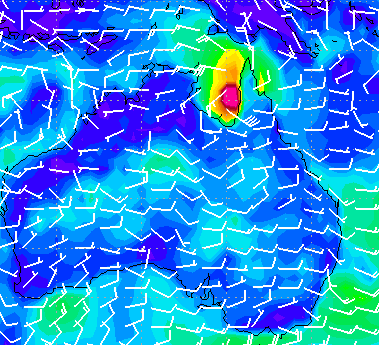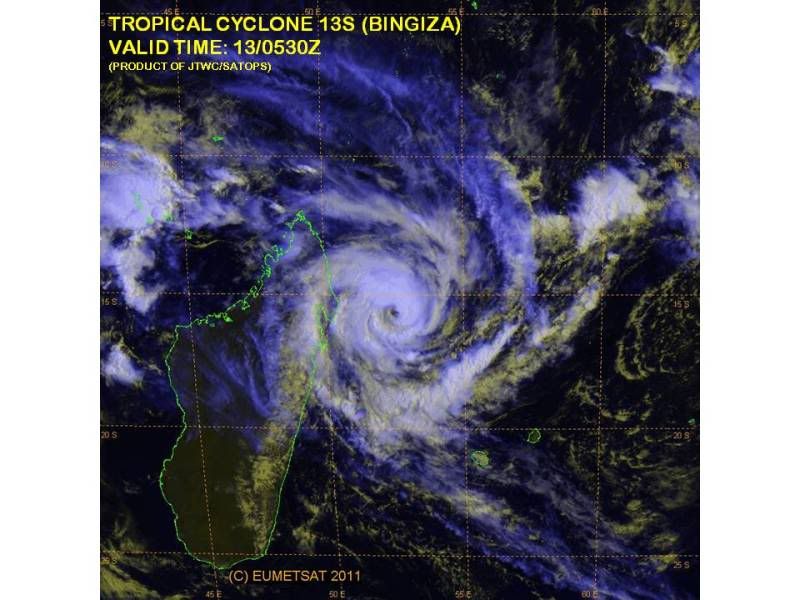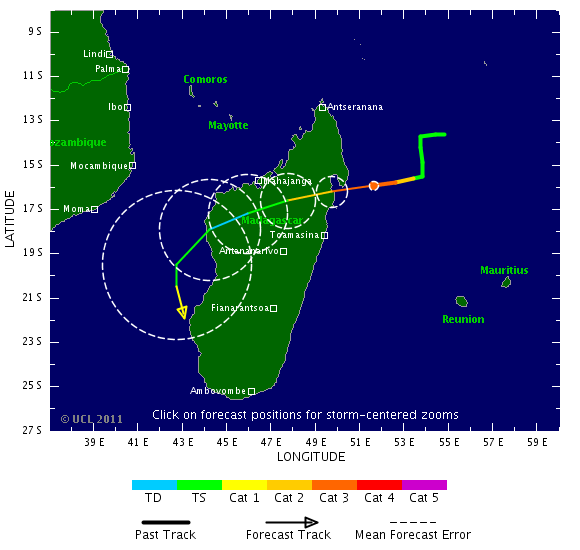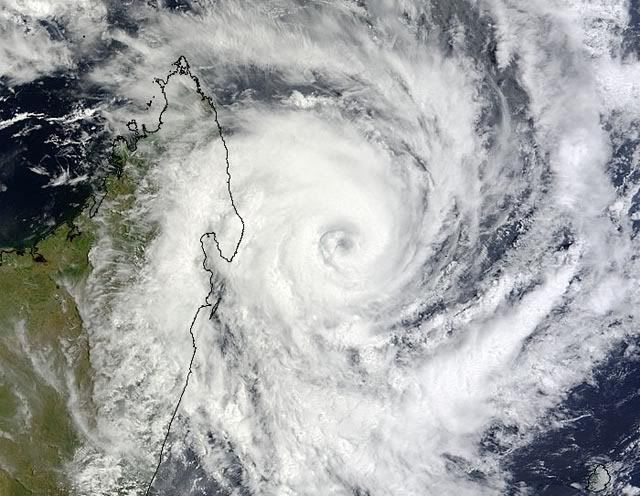WKN Weer, Klimaat en Natuurrampen
Lees alles over het onstuimige weer op onze planeet, volg orkanen en tornado's, zie hoe vulkanen uitbarsten en hoe Moeder Aarde beeft bij een aardbeving. Alles over de verwoestende kracht van onze planeet en tal van andere natuurverschijnselen.



Welkom! Hier alweer het volgende deel in de reeks Hurricane Season! Alle informatie over het ontstaan van nieuwe orkanen in 2011 vind je hier. En natuurlijk volgen we ze allemaal op de voet! Voor zowel Atlantische, Indische als Pacifische stormen kan je hier terecht
Algemene Info
Met de term 'Hurricane Season' bedoelden we in eerste instantie de periode van 1 juni tot 30 november. Deze periode wordt in de Atlantische Oceaan en de Golf van Mexico gezien als het orkaanseizoen. Echter komen deze gewelddadige stormen overal in de wereld voor en met name in Azië zorgen ze jaarlijks voor duizenden slachtoffers en tienduizenden daklozen. Echter horen we vaak erg weinig over de stormen in Azië en juist meer over die in de VS en de Caribbean.
In de laatste jaren zijn Tropische Stormen meer en meer in de media gekomen. Het lijkt ook alsof ze meer en meer slachtoffers maken. Een documentaire over Hurricane Andrew uit 1992, heeft diepe indruk gemaakt en ook zullen kenners orkanen Floyd, Gilbert, Stan en Ivan zich zeker nog herinneren. De catastrofe die "Katrina" met zich meebracht ging de hele wereld over. En dan praten we eigenlijk alleen over de Atlantische stormen en lijken we te vergeten dat er in 2007 meer dan 4000 doden vielen in Bangladesh door orkaan Sidr en orkaan Nargis zorgde voor 80.000 doden in Myanmar alleen al.
Hoewel het Atlantische seizoen pas officieel in juni begint zijn er op andere plekken in de wereld zeker meer orkanen te vinden in de komende maanden. We zullen ook deze dus zeker gaan bespreken. Waarschijnlijk zal de kern van de discussie en de posts gaan over de periode 1 juni tot 30 november. T.z.t. zal er ook wel een NWS-topic worden geopend als een orkaan ook uitgebreid in het nieuws komt.
Orkanen: Hoe ontstaan ze eigenlijk?
Op de site van Wikipedia kan je in het Nederlands nalezen hoe ze ontstaan en wat de belangrijkste energiebron is voor hun verwoestende kracht: het warme zeewater
Ook de BBC heeft er een interessante en leuke animatie over gemaakt.
Ook wordt er op LiveScience in het engels prima uitgelegd hoe ze ontstaan en zich ontwikkelen
Indeling, Kracht en Stormvloed
De stormen worden ingedeeld op 'categorie'. Vaak zijn het eerst tropische stormen" (Tropical Depression, Tropical Storms), die overgaan tot Orkaanstatus (Hurricanes/Tyfoons) Ze worden ingedeeld op windsnelheden via de Saffir-Simpson Schaal.
Door de enorme windkracht van een orkaan wordt het zeewater opgestuwd. Dit zeewater wordt als het ware vooruit geblazen, voor de storm uit. Hoe zwaarder de orkaan des te meer zeewater vooruit wordt geduwd. De stormvloed wordt dan ook gemeten bovenop de reguliere golfslag. Je kan het enigszins vergelijken met een muur van water (tsunami) die vooruit wordt geduwd.
Tropische Depressie: windsnelheden van 38 tot 61 km/u
Tropische Storm: windsnelheden van 62 tot 118 km/u
Orkaan 1e categorie: windsnelheden van 119 tot 153 km/u en een stormvloed van 1 tot 1,5 meter boven normaal
Orkaan 2e categorie: windsnelheden van 154 tot 177 km/u en een stormvloed van 1,5 tot 2,5 meter boven normaal
Orkaan 3e categorie: windsnelhden van 178 tot 209 km/u en een stormvloed van 2,5 tot 3,7 meter boven normaal
Orkaan 4e categorie: windsnelheden van 210-249 km/u en een stormvloed van 3,8 tot 5,5 meter boven normaal
Orkaan 5e categorie: windsnelheden > 250 km/u en een stormvloed van meer dan 5,5 meter boven normaal
Onderstaand schema geeft de kracht en benaming van orkanen overal ter wereld weer
TIP: Interactief (film)overzicht van de krachten van orkanen n.a.v. de schaal van Simpson
Waarom hebben orkanen namen?
De Tropische Depressies worden overal ter wereld in de gaten gehouden en zodra de depressies uitgroeien tot orkaan of cycloon, wordt er een naam aan de storm gegeven. Sinds 1950 krijgen ze namen op alfabetische volgorde (met uitzondering van de letters Q, U, X, Y en Z). Mocht een orkaan vernietigend hebben huisgehouden zoals Floyd, Gilbert en bijv. Katrina, dan zal die naam worden vervangen. Soms komt het ook voor dat alle letters van het alfabet gebruikt zijn in één seizoen (zoals 2005), dan zal een volgende storm Alpha gaan heten, gevolgd door Beta etc etc. Voor het orkanenseizoen 2010 zijn de namen als volgt:
Atlantische Stormen 2011
Arlene, Bret, Cindy, Don, Emily, Franklin, Gert, Harvey, Irene, Jose, Katia, Lee, Maria, Nate, Ophelia, Philippe, Rina, Sean, Tammy, Vince, Whitney
In het Noordoosten van de Pacific ontstaan ook orkanen. Deze orkanen zorgen vaak voor overlast in Midden-Amerika en delen van Mexico.
Oost Pacifische Stormen 2011
Adrian, Beatriz, Calvin, Dora, Eugene, Fernanda, Greg, Hilary, Irwin, Jova, Kenneth, Lidia, Max, Norma, Otis, Pilar, Ramon, Selma, Todd, Veronica, Wiley, Xina, York, Zelda
Verder zijn er dan nog de stormen in het Noordenwesten, Midden en Zuiden van de Pacific. Daar worden ze tyfoons en/of cyclonen genoemd. Vooral de stormen in het Noord/Westen komen vaak in het nieuws omdat ze Japan, de Filippijnen, Taiwan en China vaak teisteren, maar ook geheel Zuid Oost Azië kunnen treffen. Ook in de Indische oceaan komen ze voor, daar zijn vaak Bangladesh en Myanmar aan de beurt, maar soms ook India, Pakistan of zelfs Oman.
Meer informatie over de namen van orkanen vind je hier.
Leuk hoor allemaal, maar wanneer zijn die orkaanseizoenen nou precies?
ATLANTISCHE OCEAAN: 1 juni t/m 30 november
NOORD OOST PACIFIC:Begin mei t/m begin november, met piek in augustus/september
NOORD WEST PACIFIC: Begin juli t/m eind november, maar eigenlijk hele jaar door activiteit.
NOORD INDISCHE OCEAAN: april t/m december met pieken in mei en november
ZUID INDISCHE + WEST AUSTRALISCHE OCEAAN: oktober t/m mei met pieken in februari en april
ZUID WEST PACIFIC + OOST AUSTRALISCHE OCEAAN: oktober tot eind april met piek in februari.
Over het algemeen is Mei de rustigste maand en September de zwaarste.
En? Zijn er al verwachtingen en/of voorspellingen voor 2011?
Begin december kwamen de eerste voorspellingen voor 2011 naar buiten. Ze verwachten wederom een zeer actief seizoen. 50 jaar orkaangeschiedenis heeft een zogenaamd gemiddeld orkaanseizoen gecreëerd. Namelijk: 9,6 stormen met naam, 5,9 groeit uit tot orkaan en 2,3 worden superorkanen (cat 4 of 5) Volgens de december verwachting krijgen we 17 tropische stormen in de Atlantische Oceaan. Negen groeien daarvan uit tot orkaan en vijf daarvan zullen superorkanen worden. Er is een kans van 73% dat één van deze 5 superorkanen de kust van de VS zal gaan treffen. Deze voorspelling kan je hier nog eens nalezen.
Waait het nou echt zo hard bij zo'n orkaan?
Oude Delen
2004 - Deel 1 en Deel 2
2005 - Deel 1 en Deel 2
2006 - Deel 1 en Deel 2
2007 - Deel 1, Deel 2, Deel 3 en Deel 4
2008 - Deel 1 en Deel 2
2009 - Deel 1 en Deel 2
2010 - Deel 1 , Deel 2 . Deel 3 en Deel 4
Enkele Links
1. National Hurricane Centre
2. Carribean Storm Network
3. Hurricanezone
4. Hurricane Track
5. Website met satelietbeelden van de Caribbean en de rest van Amerika
6. Intellicast: Geavanceerde satellietfoto's en gifs van aktuele stormen
7. Tropical Weather Underground
8. Tropical Storm Risico's van dit moment
9. Wikipedia Hurricanes/Tyfonen in het algemeen
10. Alle stormen ter wereld van de laatste jaren in overzicht
11. The StormTrack
12. Orkanensite in de Filipijnen
13. Atlantische Orkanensite
14. Actuele orkanen in Australië en De orkaanindeling in Australië
15. Tropische weersite omgeving Australië
16. Mooie site over Orkanen aan de VS kusten
17. Website van NASA over Hurricanes
Opmerkelijke Wikipedia-Links
-- Hurricane Katrina 2005
-- Cyclone Nargis 2008
-- Hurricane Season 2011 - Wikipedia
-- Hurricane Season 2010 - Wikipedia
-- Hurricane Season 2009 - Wikipedia
-- Hurricane Season 2008 - Wikipedia
-- Hurricane Season 2007 - Wikipedia
-- Hurricane Season 2006 - Wikipedia
-- Hurricane Season 2005 - Wikipedia
-- Hurricane Season 2004 - Wikipedia
Actuele Weerradar in Golf van Mexico
Actuele Water temperatuur.
=====================
Heb je informatie over orkanen of wil je gewoon alle orkanen van 2011 volgen, volg dan dit topic
[ Bericht 0% gewijzigd door Frutsel op 15-02-2011 21:26:15 ]


Interessant... voor 2010 werd een boven gemiddeld orkaanseizoen voorspeld... toch leek dat eigenlijk niet zo, want de US werd zo goed als niet getroffen, maar toch waren er aardig wat stormen.
Voor 2011 voorspellen ze nu een zeer agressief orkaanseizoen
Voor 2011 voorspellen ze nu een zeer agressief orkaanseizoen
Lees hier meer over deze voorspellingquote:CSU and TSR predict an extremely active 2011 Atlantic hurricane season
A continuation of the pattern of much above-average Atlantic hurricane activity we've seen since 1995 is on tap for 2011, according to the latest seasonal forecast issued Wednesday by Dr. Phil Klotzbach and Dr. Bill Gray of Colorado State University (CSU). They are calling for 17 named storms, 9 hurricanes, and 5 intense hurricanes. An average season has 10 - 11 named storms, 6 hurricanes, and 2 intense hurricanes. The new forecast is a very aggressive one, since only six seasons since 1851 have had as many as 17 named storms; 19 seasons have had 9 or more hurricanes. The 2011 forecast calls for a much above-average chance of a major hurricane hitting the U.S., both along the East Coast (49% chance, 31% chance is average) and the Gulf Coast (48% chance, 30% chance is average). The Caribbean is forecast to have a 62% chance of seeing at least one major hurricane (42% is average.) Five years with similar pre-season November atmospheric and oceanic conditions were selected as "analogue" years that the 2011 hurricane season may resemble: 2008, 1999, 1989, 1961, and 1956. The average activity for these years was 12 named storms, 7 hurricanes, and 4 major hurricanes.
The forecasters cited several reasons for their forecast of a much above-average season:
1) Unusually warm sea surface temperatures continue in the tropical Atlantic this fall, an indication that the active hurricane period we have been in since 1995 will continue (in technical terms, the positive phase of the Atlantic Multidecadal Oscillation, AMO, will continue.) SSTs in Atlantic Main Development Region (MDR) for hurricanes, from the Caribbean eastwards to the coast of Africa, were at a record high in October (November data are not yet available.)
2) Hurricane activity in the Atlantic is lowest during El Niño years and highest during La Niña or neutral years. This occurs because El Niño events tend to increase westerly upper-level winds over the tropical Atlantic, bringing high wind shear harmful for hurricanes. The CSU team notes that we are currently experiencing moderate to strong La Niña conditions, with an unusual amount of cool water present in the top 300 meters of the Equatorial Pacific Ocean off the coast of South America. Since 1979, only eight years have had similar amounts of cool water in November. The hurricane seasons that followed each of those eight years were unable to transition to El Niño conditions. Thus, the CSU team expects that we will have neutral or La Niña conditions in place for the Atlantic hurricane season of 2011, which should act to keep wind shear values average to below average, enhancing hurricane activity. Of the 16 El Niño/La Niña computer models that made November predictions for the July-August-September 2011 portion of hurricane season (Figure 1), only 4 (25%) predicted that El Niño would arrive.
2011 Atlantic hurricane season forecast from Tropical Storm Risk, Inc.
The British private forecasting firm Tropical Storm Risk, Inc. (TSR), issued their 2011 Atlantic hurricane season forecast on Monday. They are also calling for a very active year: 15.6 named storms, 8.4 hurricanes, and 4 intense hurricanes. TSR predicts a 66% chance of an above-average hurricane season, 22% chance of a near-normal season, and only a 12% chance of a below normal season. TSR bases their December forecast on predictions that sea surface temperatures next fall in the tropical Atlantic will be above about 0.3°C above average, and trade wind speeds will be about 0.7 m/s slower than average. The trade wind speed prediction is based on a forecast for a weak La Niña in August-September 2011.
I like how TSR puts their skill level right next to the forecast numbers: 2% skill above chance at forecasting the number of named storms, 1% skill for hurricanes, and 7% skill for intense hurricanes. That's not much skill, and really, we have to wait until the June 1 forecasts by CSU, NOAA, and TSR to get a forecast with reasonable skill.


Met dank aan: Onweer-Onlinequote:Wederom een druk orkaanseizoen verwacht
Het Atlantisch orkaanseizoen van 2011 zal na verwachting net zo druk gaan verlopen als in 2010, dat hebben meteorologen van het Colorado State University bekend gemaakt. Er wordt verwacht, dat er 17 tropische stormen gaan ontstaan waarvan er negen zullen uit groeien tot orkaan. Vijf van de negen orkanen zullen uitgroeien tot "major hurricane" van categorie 3 of hoger, met windsnelheden van minstens 178 km per uur of hoger. Het Atlantisch orkaanseizoen loopt van 1 juni tot en met 30 november.
Vorig orkaanseizoen kwamen er 19 tropische stormen voor, waarvan er 12 uitgroeiden tot orkaan. Van deze twaalf orkanen kregen er vijf de status major hurricane. Het orkaanseizoen van 2010 staat op de derde plaats wat betreft de activiteit, alleen in de jaren 1887 en 1995 werden er meer stormen geregistreerd. In een gemiddeld orkaanseizoen brengt ongeveer elf stormen voort. Zes hiervan bereiken orkanen status. Twee orkanen groeien uit tot major hurricane in de Atlantische Oceaan, het Caribisch gebied en de Golf van Mexico.
Boven de Atlantische Oceaan, de Caribische Zee en de Golf van Mexico komen tijdens El Niño gemiddeld minder orkanen voor in tegenstelling tot de periode van La Niña, waarin er meer orkanen onstaan. Aan de westkust van Mexico en de Verenigde staten komen bij El Niño juist meer orkanen aan land. Men verwacht, dat het onwaarschijnlijk is, dat er een El Niño zich zal gaan ontwikkelen. Dit houdt in, dat er een actief orkaanseizoen aan zit te komen, aldus Philip Klotz, hoofd van Colorado State Universiteit.
Er is een grote mate van onzekerheid in de prognoses, maar meteorologen zijn nauwkeuriger geworden in het analyseren van grootschalige patronen en het voorspellen van een orkaanseizoen. Dit kan nuttig zijn voor het bedrijfsleven waaronder verzekeraars, boeren en energiemaatschappijen, die getroffen kunnen gaan worden door orkanen.
Op korte termijn zijn de weerpatronen bepalend, net zoals afgelopen jaar. Niemand voorzag, dat de droge lucht massa's en de straalstroom ervoor zorgden, dat de stormen en orkanen zich verwijderden van het vaste land van de Verenigde Staten. Vorig haar heeft geen enkele van de 12 gevormde orkanen de kust van de Verenigde Staten bereikt, waardoor de inwoners voor grote rampen bespaard zijn gebleven. Gemiddeld komt één op de vier orkanen aan land. Dit jaar verwachten de meteorologen, dat enkele orkanen wel het vaste land gaan bereiken.


Oh en voor als je niet weet wat ik bedoel:
quote:En natuurlijk volgen we ze allemaal op de voet! Voor zowel Atlantische, Indische als Pacifische stormen kan je hier terecht



Bij Australie worden er 6 verwacht dit seizoen.
bronquote:Zes cyclonen
De ellende is nog lang niet voorbij in Australië. In Queensland vrezen specialisten dat het stormseizoen nog een grote cycloon in petto heeft. Het seizoen duurt nog drie maanden en dus zou er nog veel neerslag uit de lucht kunnen vallen. Zeker tot woensdag zal het waterniveau blijven stijgen.
In november hadden weerkundigen een seizoen met zes cyclonen voorspeld


Ja dat zijn verwachtingen, maar blijkbaar kunnen ze dat ook al niet meer 
Doe mee met het voorspellen van het weer!
Weekvoorspelling | Week 52 (invullen tot 22-12 - 11:59)
Maandvoorspelling December(Gesloten)
Jaarvoorspelling 2024 / 2025
Weekvoorspelling | Week 52 (invullen tot 22-12 - 11:59)
Maandvoorspelling December(Gesloten)
Jaarvoorspelling 2024 / 2025


De storm zit ook in de nieuwe run van GFS. Ik heb er even een gifje van gemaakt.
Ook aan de oostkant van van Australie lijkt er een storm te ontstaan. Deze trekt niet richting land (niet richting Australie in ieder geval)
Ook aan de oostkant van van Australie lijkt er een storm te ontstaan. Deze trekt niet richting land (niet richting Australie in ieder geval)


Het systeem aan de westkant van Australie gaat woensdag uitgroeien tot een cycloon
quote:At 9am Monday another low was located near 15S 112E and was nearly stationary.
This low is currently in an unfavourable environment but conditions for
development are likely to improve by Wednesday.
Likelihood of this system being a tropical cyclone in the Western Region:
Tuesday :Low
Wednesday :High
Thursday :High


Als die nou eens voor NL bestemt was mag van mij de winter gestolen worden 
Doe mee met het voorspellen van het weer!
Weekvoorspelling | Week 52 (invullen tot 22-12 - 11:59)
Maandvoorspelling December(Gesloten)
Jaarvoorspelling 2024 / 2025
Weekvoorspelling | Week 52 (invullen tot 22-12 - 11:59)
Maandvoorspelling December(Gesloten)
Jaarvoorspelling 2024 / 2025


Het is nu nog een tropische depressie, maar zal in kracht toenemen en richting land trekken.
De orkaanschaal in Australie is net iets anders dan de schaal die we normaal gebruiken.
De orkaanschaal in Australie is net iets anders dan de schaal die we normaal gebruiken.


Of zal die nog meer ellende veroorzakenquote:Op dinsdag 11 januari 2011 16:29 schreef Frutsel het volgende:
Gaat die dan die bosbranden daar blussen?
Doe mee met het voorspellen van het weer!
Weekvoorspelling | Week 52 (invullen tot 22-12 - 11:59)
Maandvoorspelling December(Gesloten)
Jaarvoorspelling 2024 / 2025
Weekvoorspelling | Week 52 (invullen tot 22-12 - 11:59)
Maandvoorspelling December(Gesloten)
Jaarvoorspelling 2024 / 2025


quote:At 8am WST Tuesday a low [09U] was located near 14.9S 108.3E and was moving west
at 19 kilometres per hour. This low is likely to develop into a tropical
cyclone on Wednesday, by which time it will be tracking eastwards towards the
Pilbara coast. It is not expected to affect the coast on Wednesday or Thursday.
Likelihood of this system being a tropical cyclone in the Western Region:
Wednesday :High
Thursday :High
Friday :High


Het is allemaal weer lekker op dreef 
Misschien wordt het dit jaar toch een actief seizoen?
Misschien wordt het dit jaar toch een actief seizoen?
Doe mee met het voorspellen van het weer!
Weekvoorspelling | Week 52 (invullen tot 22-12 - 11:59)
Maandvoorspelling December(Gesloten)
Jaarvoorspelling 2024 / 2025
Weekvoorspelling | Week 52 (invullen tot 22-12 - 11:59)
Maandvoorspelling December(Gesloten)
Jaarvoorspelling 2024 / 2025


quote:Tropical Cyclone Vania may hit New Zealand
A tropical cyclone may be heading for New Zealand as a tropical depression continues to deepen.
According to WeatherWatch.co.nz, the tropical depression is currently lying over warm waters between Vanuatu and New Caledonia.
And the conditions are favourable for it to become a tropical cyclone, with New Caledonia likely to take a direct hit.
"A direct hit to New Zealand is not out of the question,” says head weather analyst Philip Duncan.
He says the storm may have an impact on the upper half of New Zealand.
"We still have no clear path on where this tropical storm will track but the North Island does look as though it will be in its sights.
"One model shows the low drifting across the North Island from the Taranaki region, while the other two models favour a Northland or East Cape strike.
“It's possible there's a fourth option where the low is pushed further east of the country, but either way it's something we should be aware of,” says Mr Duncan.
On the up side, Mr Duncan says heavy rain appears to be the main feature with this low, which may bring much needed water to dry parts of the North Island, but potentially a wet and windy time for campers in Northland and Coromandel Peninsula.
"The low is likely to start impacting New Zealand at the weekend. It's too early to be sure of its exact path so we advise people to keep up to date with WeatherWatch.co.nz news updates over the coming days.”
Mr Duncan says there is currently a moderate chance of New Zealand being impacted by the low.


VANIA gaat in kracht toenemen en zal waarschijnlijk als een categorie 1 Nieuw-Caledonië gaan treffen.


quote:WA operators on Cyclone alert
Tropical cyclone Vince is headed towards Australia's north-west coast, home to some of the country’s largest oil and gas facilities.
The weather bureau said the cyclone was currently 1050 km north-west of the town of Exmouth and is expected to move south-east for the next 48 hours and then curve back to the south-west, moving parallel to the coast.
Much of Australia's offshore oil and gas production, including the A$20 billion (US$19.742 billion) North West Shelf liquefied natural gas export project operated by Woodside , are located off the north-west coast.
Apache Energy is currently monitoring the cyclone movement, which may approach Apache facilities in the area over the next two to three days, but has taken no further action, Reuters reported.
Woodside said that it was preparing its facilities, but that there was currently no impact to production.
Woodside, Apache Energy, and BHP Billiton have all been forced to shut offshore operations as a precaution for brief periods since the beginning of the current cyclone season.
Cyclones off Australia's north-west annually force offshore oil and gas platforms to shut down temporarily.
Australia is facing almost double the usual number of destructive tropical cyclones, possibly as many as 22, during the current cyclone season, the weather bureau said in October.
The largest increase in cyclones is expected off the north-west, with 11-12 cyclones predicted, compared with an average of seven.


Het is nog niet helemaal duidelijk wat Vince gaat doen.
[ Bericht 22% gewijzigd door #ANONIEM op 12-01-2011 19:00:37 ]
[ Bericht 22% gewijzigd door #ANONIEM op 12-01-2011 19:00:37 ]


Vanuatu en Nieuw-Caledonië krijgen het flink te verduren. Vania gaat nog in kracht toenemen. De meeste neerslag zit nu boven Vanuatu (eilanden met als hoofdstad Port Vila (29.356 inwoners))
De cycloon trekt nu richting Nieuw-Caledonië (227.436 inwoners)
De cycloon trekt nu richting Nieuw-Caledonië (227.436 inwoners)


Eh, is de definitie van "een bovengemiddeld orkaanseizoen" dat de USA vaak getroffen dient te worden? Lijkt me niet.quote:Op donderdag 6 januari 2011 18:55 schreef Frutsel het volgende:
Interessant... voor 2010 werd een boven gemiddeld orkaanseizoen voorspeld... toch leek dat eigenlijk niet zo, want de US werd zo goed als niet getroffen, maar toch waren er aardig wat stormen.
Dat de USA afgelopen jaar niet vaak geraakt is komt door heersende windstromingen en niet doordat er weinig orkanen of stormen waren, imho.
NOAA noemt 2010 zelfs een extreem druk Atlantisch orkaanseizoen...


Daarom zeg ik ook "het leek van niet"... want we hebben er niet veel over gehoord in de media, juist omdat er nauwelijks landfall was.quote:Op woensdag 12 januari 2011 19:57 schreef cynicus het volgende:
[..]
Eh, is de definitie van "een bovengemiddeld orkaanseizoen" dat de USA vaak getroffen dient te worden? Lijkt me niet.
Dat de USA afgelopen jaar niet vaak geraakt is komt door heersende windstromingen en niet doordat er weinig orkanen of stormen waren, imho.
NOAA noemt 2010 zelfs een extreem druk Atlantisch orkaanseizoen...
Daarbij komt dat er wel bovengemiddelde verwachtingen waren, dus ook voor eventuele landfall in de VS of de Carribean.


Tropical Cyclones in Indian, South Pacific Oceans
Two tropical cyclones are churning the tropical waters of the Southern Hemisphere as of Wednesday.
Tropical Cyclone Vania has spun up near the South Pacific island nation of Vanuatu. The center was within 125 miles, or 200 km, of Port-Vila, Vanuatu.
Having highest sustained winds of 50 mph, Vania was nearly stationary with a sluggish drift towards the southwest.
Cyclone Vania on Jan. 12, 2011. (Navy Research Lab Monterey).
Vania's greatest threat, rather than Vanuatu, is to the island of New Caledonia, which it could strike directly with hurricane gusts and flooding rain as early as Friday.
Meanwhile, far to the west, Tropical Cyclone Vince whirls over open seas well off northwestern Australia.
The location of Vince is about 750 miles, or 1200 km, west-northwest of Port Hedland, Australia.
Cyclone Vince on Jan 12, 2011 (Navy Research Lab Monterey).
Vince holds highest sustained winds of 45 mph, and the storm is tracking a little south of east at 8 mph.
Warm waters will help to promote strengthening of this tropical cyclone as it heads towards the east through Friday. Thereafter, movement is less certain and could shift substantially.
Much of the northwest coast of Australia is sparsely settled. However, there are important mineral loadings sites and off-shore petroleum production sites that could be adversely affected by a tropical cyclone.
Bron: Accuweather
[ Bericht 1% gewijzigd door #ANONIEM op 12-01-2011 22:16:01 ]
Two tropical cyclones are churning the tropical waters of the Southern Hemisphere as of Wednesday.
Tropical Cyclone Vania has spun up near the South Pacific island nation of Vanuatu. The center was within 125 miles, or 200 km, of Port-Vila, Vanuatu.
Having highest sustained winds of 50 mph, Vania was nearly stationary with a sluggish drift towards the southwest.
Cyclone Vania on Jan. 12, 2011. (Navy Research Lab Monterey).
Vania's greatest threat, rather than Vanuatu, is to the island of New Caledonia, which it could strike directly with hurricane gusts and flooding rain as early as Friday.
Meanwhile, far to the west, Tropical Cyclone Vince whirls over open seas well off northwestern Australia.
The location of Vince is about 750 miles, or 1200 km, west-northwest of Port Hedland, Australia.
Cyclone Vince on Jan 12, 2011 (Navy Research Lab Monterey).
Vince holds highest sustained winds of 45 mph, and the storm is tracking a little south of east at 8 mph.
Warm waters will help to promote strengthening of this tropical cyclone as it heads towards the east through Friday. Thereafter, movement is less certain and could shift substantially.
Much of the northwest coast of Australia is sparsely settled. However, there are important mineral loadings sites and off-shore petroleum production sites that could be adversely affected by a tropical cyclone.
Bron: Accuweather
[ Bericht 1% gewijzigd door #ANONIEM op 12-01-2011 22:16:01 ]


quote:New Caledonia on cyclone alert
New Caledonia's Loyalty Islands were on maximum alert for Cyclone Vania after it brought gale-force winds to Vanuatu.
The New Caledonian domestic airline grounded all flights until further notice.
The category 2 storm damaged food crops and small buildings in Vanuatu.
The weather bureau said it received widespread reports of low-level damage but communication with some islands, including Tanna, was cut after a phone tower was blown over.
New Caledonian officials say it could bring winds of up to 110 kilometres an hour to the Loyalty Islands and to the main island later.
Low-lying areas have been evacuated, businesses and schools are closed, and residents have been warned to take shelter and avoid coastal areas.


Ten oosten van Australie is ook weer een tropische depressie aktief
quote:SITUATION
At 1200 UTC a Tropical Low was centred within 60 nautical miles of
latitude thirteen decimal five south (13.5S)
longitude one hundred and forty nine decimal six east (149.6E)
Recent movement : north northwest at 6 knots
Maximum winds : 30 knots
Central pressure: 997 hPa
The low may develop into a tropical cyclone during the next 24 hours.
AREA AFFECTED
Within 60 nautical miles of the centre.
FORECAST
Clockwise winds 15/25 knots, increasing to 25/35 knots over the northern half.
Very rough seas developing.
Forecast positions
At 0000 UTC 14 January: Within 150 nautical miles of 13.2 south 150.8 east
Central pressure 995 hPa.
Winds to 35 knots near centre.
At 1200 UTC 14 January: Within 180 nautical miles of 14.4 south 152.1 east
Central pressure 989 hPa.
Winds to 40 knots near centre.


Vania is nog een tropische storm met een windsnelheid van 109 km/uur.
Neerslag komt op sommige plaatsen boven de 150 mm
Neerslag komt op sommige plaatsen boven de 150 mm


Orkanen over Nieuw Zeeland, "Gebeurd zoiets wel eens?" vroeg ik me af. En toen vond ik dit artikel uit 1892.
En een historisch lijstje (interessante link trouwens):
Maar goed, er kan nog zoveel gebeuren voordat die storm/orkaan daar is.
En een historisch lijstje (interessante link trouwens):
Maar goed, er kan nog zoveel gebeuren voordat die storm/orkaan daar is.


Ik verwacht geen orkaan voor Nieuw Zeeland. Dat ligt veel te zuidelijk. Zal waarschijnlijk bij een tropische storm/depressie blijven. Wat natuurlijk ook voor veel overlast kan gaan zorgen.


Op weg naar Nieuw Zeeland. Watertemperatuur ligt hier net onder de 22 graden.
Nieuw Caledonie komt ook weer dicht in de buurt voor deze cycloon.
[ Bericht 14% gewijzigd door #ANONIEM op 14-01-2011 19:16:09 ]
Nieuw Caledonie komt ook weer dicht in de buurt voor deze cycloon.
[ Bericht 14% gewijzigd door #ANONIEM op 14-01-2011 19:16:09 ]


Zelia is nu een categorie2 orkaan met een windsnelheid van 168 km/uur en windstoten tot 201 km/uur. Dinsdag nadert deze Nieuw Zeeland. Zelia zal dan afgezwakt zijn tot tropische storm.


ABC Newsquote:Norfolk Island spared cyclone's wrath
Norfolk Island has been spared the full force of Tropical Cyclone Zelia, which is now moving to the east of the island.
Earlier, it was predicted to move directly across the island but it is currently about 60 kilometres to the north-east and is rapidly moving further off shore.
The weather bureau says it has been downgraded to a category two cyclone and is unlikely to cause any significant damage.
The bureau says winds could reach gale force in the next few hours and seas could rise up to seven metres.


Anthony gaat rechtsomkeer maken en lijkt (volgens GFS) over een aantal dagen aan land te gaan in het noorden van Queensland. Wat voor nieuwe overstromingen kan gaan zorgen.
Wilma ligt nu boven de Samoa eilanden en zal koers zetten richting de Tonga eilanden.
[ Bericht 9% gewijzigd door #ANONIEM op 23-01-2011 14:08:54 ]
Wilma ligt nu boven de Samoa eilanden en zal koers zetten richting de Tonga eilanden.
[ Bericht 9% gewijzigd door #ANONIEM op 23-01-2011 14:08:54 ]


quote:Existing Cyclones in the Eastern Region:
Tropical Cyclone Anthony is moving east in the northern Coral Sea and slowly
strengthening. Likelihood of TC Anthony remaining a tropical cyclone in Eastern
Region on:
Monday: High
Tuesday: High
Wednesday: High
quote:Potential Cyclones:
At 8am WST a tropical low was located just off the Kimberley coast near latitude
14.3S longitude 128.8E, about 75 kilometres west of Port Keats, moving north at
6 kilometres per hour. The low is expected to move in a generally westwards
direction and be in the Western region [west of 125E] just off the Kimberley
coast on Tuesday. During the week the low is expected to move towards the
southwest parallel to the Pilbara coast. The low may develop into a tropical
cyclone late on Tuesday or more likely on Wednesday.
Likelihood of this system being a tropical cyclone in the Western Region:
Monday :Low
Tuesday :Moderate
Wednesday :High
[ Bericht 52% gewijzigd door #ANONIEM op 23-01-2011 16:02:35 ]


en volgens dat plaatje wordt het wel iets meer dan een Cat 1quote:Op zondag 23 januari 2011 13:31 schreef aloa het volgende:
Anthony gaat rechtsomkeer maken en lijkt (volgens GFS) over een aantal dagen aan land te gaan in het noorden van Queensland. Wat voor nieuwe overstromingen kan gaan zorgen.
[ afbeelding ]
Wilma ligt nu boven de Samoa eilanden en zal koers zetten richting de Tonga eilanden.
[ afbeelding ]
[ afbeelding ]


Anthony is wat in kracht afgenomen en lijkt de status van orkaan niet te gaan halen.
quote:Existing Cyclones in the Eastern Region:
Tropical Cyclone Anthony is moving east southeast over the central Coral Sea.
Likelihood of Tropical Cyclone Anthony remaining as a cyclone in the Eastern
Region on:
Tuesday: Moderate
Wednesday: Moderate
Thursday: Moderate


quote:Wilma has hit American Samoa
Tropical Cyclone Wilma has hit American Samoa and triggered alerts in other island countries in the central South Pacific, Radio New Zealand International reported on Monday.
American Samoa's Emergency Center said the Category 1 storm has winds of up to 110 km/h and gusts in excess of 130 km/h.
The storm has hit eastern villages, downing power lines, and is due to sweep over the western island of Tutuila.
So far there have been some landslides and debris on the road reported, as well as minor damage to some roofs and houses.
A marine warning said there was a hazardous surf up to 5 meters high throughout the storm, causing some flooding.
Pago Pago International Airport is still closed and it's not clear when inter island flights can resume.
American Samoa Governor, Togiola Tulafono, has activated the Emergency Operations Center, bringing together ten government agencies for a coordinated response.
As the cyclone heads south, it will also affect Samoa's main island, Upolu.
An alert is also in place for Tonga's northern islands.
For Tokelau, an alert is still in force, but winds there are expected to ease.


Bij West Australie lijkt ook een systeem te ontstaan.
[ Bericht 6% gewijzigd door #ANONIEM op 24-01-2011 19:11:25 ]
quote:A Tropical Cyclone Advice [IDW24100] is current for a developing tropical low.
At 8am WST Monday a tropical low was located over the north Kimberley near
latitude 14.7S longitude 127.1E, about 65 kilometres southeast of Kalumburu,
moving west at 16 kilometres per hour. Please refer to the latest Advice. The
low is expected to move in a generally westwards direction and be in the Western
region [west of 125E] just off the Kimberley coast on Tuesday. During the week
the low is expected to move towards the southwest parallel to the Pilbara coast.
The low may develop into a tropical cyclone late on Tuesday or more likely on
Wednesday.
Likelihood of this system being a tropical cyclone in the Western Region:
Tuesday :Moderate
Wednesday :High
Thursday :High
[ Bericht 6% gewijzigd door #ANONIEM op 24-01-2011 19:11:25 ]


Accuweatherquote:Tropical Cyclone Brings Heavy Rain to Western Australia
A tropical cyclone will continue to affect northwestern Australia over the next few days. The cyclone formed Sunday over the Timor Sea and quickly moved inland across the Kimberley area of Western Australia. It is expected to reemerge offshore, gain strength, and brush much of the northern coast of Western Australia over the next few days.
Heavy rainfall has affected areas along the track of the cyclone. Kalumburu had 6.42 inches Monday, and Theda had nearly 7 inches.
The cyclone is maintaining good organization despite being over land. It will emerge back into the Indian Ocean early Tuesday, local time. It should quickly gain tropical storm strength, then parallel the Kimberley coast through Wednesday. Tropical storm conditions are most likely in the communities of Beagle Bay, Cape Leveque, and Kuri Bay. Tropical storm conditions are possible in the towns of Port Hedland and Exmouth Wednesday and Thursday.
Port Hedland is Australia's busiest port. It serves as an export point for iron ore, and other minerals mined across Western Australia. However, Port Hedland should not suffer a direct hit by the cyclone.
Fortunately, Western Australia has been spared the devastating flooding that has affected much of the rest of the country.


Tropische Cycloon Wilma met een windsnelheid van 120 km/uur ( waarmee het een categorie 1 wordt) en windstoten tot 144 km/uur, op weg naar de Tonga eilanden


Met een windsnelheid van 168 km/uur en windstoten tot 201 km/uur trekt Wilma als een cat 2 zuidwaarts richting Nieuw Zeeland. In de buurt van Nieuw Zeeland zal de cycloon in kracht afnemen tot tropische storm. (watertemperatuur is hier rond de 22 graden).
Bianca heeft een windsnelheid van 104 km/uur met windstoten tot 128 km/uur. Bianca trekt langs de westkust van Australie en zal (nu nog tropische storm) in kracht toenemen tot categorie 1 en daarna categorie 2
Bianca heeft een windsnelheid van 104 km/uur met windstoten tot 128 km/uur. Bianca trekt langs de westkust van Australie en zal (nu nog tropische storm) in kracht toenemen tot categorie 1 en daarna categorie 2


Wilma is inmiddels opgewaardeerd naar een categorie 4
Windsnelheid van 209 km/uur met windstoten tot257 km/uur
[ Bericht 14% gewijzigd door #ANONIEM op 26-01-2011 09:41:52 ]
Windsnelheid van 209 km/uur met windstoten tot257 km/uur
[ Bericht 14% gewijzigd door #ANONIEM op 26-01-2011 09:41:52 ]


Kaartje voor 1 februari.
Weer een cycloon voor Nieuw Caledonie? (en misschien voor Australie)
[ Bericht 7% gewijzigd door #ANONIEM op 26-01-2011 15:07:20 ]
Weer een cycloon voor Nieuw Caledonie? (en misschien voor Australie)
[ Bericht 7% gewijzigd door #ANONIEM op 26-01-2011 15:07:20 ]


quote:Tropical Cyclone activity heats up near Australia
The year's first Category 4 tropical cyclone is Tropical Cyclone Wilma, which is churning the waters near Tonga in the Southern Hemisphere with sustained winds of 135 mph (minimum Category 4 strength.) Wilma passed over American Samoa as a strong tropical storm, and hit Tonga as a Category 3 storm. Substantial damage has been reported on Tonga, but no deaths or injuries. Wilma is recurving out to sea, and will not affect Australia.
Australia is keeping an eye on Tropical Cylone Bianca, which is expected to skirt the northwest coast of the country over the next few days. Of much greater concern for Australia are two potential tropical cyclones that could hit the flood-ravaged state of Queensland next week. Both the European Center and GFS models predict that the remains of Tropical Cyclone Anthony will regenerate into a tropical storm late this week and hit Queensland early next week. A second and potentially more powerful storm is forecast to form next week in the islands to the east of Australia, and threaten Queensland at the end of the week. This is potentially terrible news for Australia, which is attempting to recover from record floods. As reported in the latest Bureau of Meteorology climate statement and flood summary, the past four months (September - December) have been the rainiest such period in Queensland's history, and the resulting flooding disaster has been Australia's most expensive natural disaster in history.


Het lijkt er inderdaad op dat Anthony weer tot leven komt en zo'n beetje hetzelfde gebied in trekt waar de vorige tropische storm (Tasha) voor het begin van de overstromingen zorgde. En volgende week nadert waarschijnlijk nog een cycloon.quote:
restanten anthony kaartje 30 januari
cycloon voor volgende week 3 februari


Met een windsnelheid van boven de 120 km/uur en windstoten tot 144 km/uur is Bianca een categorie 1 cycloon geworden en trekt langs de Westkust van Australie.
Bianca
Wilma is met een windsnelheid van 185 km/uur en windstoten van 233 km/uur op weg naar Nieuw Zeeland. Wilma is nu een categorie 3 en zal afzwakken tot Tropische storm, als het Nieuw Zeeland bereikt.
Wilma
Bianca
Wilma is met een windsnelheid van 185 km/uur en windstoten van 233 km/uur op weg naar Nieuw Zeeland. Wilma is nu een categorie 3 en zal afzwakken tot Tropische storm, als het Nieuw Zeeland bereikt.
Wilma


De restanten van Anthony kunnen zich weer ontwikkelen in een tropische cycloon
quote:SITUATION
At 0600 UTC Ex-Tropical Cyclone Anthony was centred within 15 nautical miles of
latitude seventeen decimal four south (17.4S)
longitude one hundred and fifty four decimal eight east (154.8E)
Recent movement : west northwest at 9 knots
Maximum winds : 35 knots
Central pressure: 998 hPa
Ex-Tropical Cyclone Anthony may redevelop into a tropical cyclone during the
next 6 to 18 hours.


quote:Cyclone Wilma to rock north
Parts of the upper North Island are in for a gusty weekend with exceptionally strong winds and possible flooding forecast as a cyclone moves past the country.
Tropical Cyclone Wilma is near New Caledonia and is due here late tomorrow night, the MetService says.
"It should sideswipe the northeastern parts of Northland on Saturday morning, then get pushed off to the southeast and sideswipe Gisborne on Sunday evening. Then it will move way off to the east of us," said MetService weather ambassador Bob McDavitt.
The MetService has issued severe rain warnings for Auckland, eastern Waikato, Coromandel Peninsula, Bay of Plenty and Gisborne for tomorrow morning, saying slips or flooding are possible.
The heaviest rainfall is expected in Northland where 150mm to 200mm may fall within 24 hours. Mr McDavitt said the rain would be accompanied by gales.
"The cyclone has very tight isobars around it which makes the winds very strong."
Weather Watch chief analyst Philip Duncan said the upper North Island might have flooding similar to last Sunday's.
"Because it's a tropical storm it has very, very heavy rain which is not too good for the long weekend. And the winds will be gale force further north which is exceptionally strong ...
"But the good news is that when the winds pick up you know the rain's about to stop."
He said the cyclone would not affect the temperature and he has forecast between 24C and 26C for most of the upper North Island.
"The humidity may increase a little bit, but it won't get as bad as we've had recently."
Mr Duncan said the severe wind and rain would move off the country quickly with the promise of clear weather on Sunday and Monday.
"It's a quite a fast-moving weather system."


Bianca is inmiddels een categorie 4 en trekt langs de westkust van Australie. Windsnelheid is nu 209 km/uur met windstoten tot 257 km/uur.
Het lijkt er op dat Bianca als tropische storm landfall zal maken in het zuidwesten van Australie, in de buurt van Perth.
Het lijkt er op dat Bianca als tropische storm landfall zal maken in het zuidwesten van Australie, in de buurt van Perth.


De verwachting is dat Anthony zal terugkeren als cycloon en aan land zal gaan in het Noorden van Queensland. Bij de fiji eilanden ontwikkeld zich een nieuw systeem wat komende donderdag voor overlast kan gaan zorgen in Queensland.
quote:Cyclones menace WA, north Queensland
Emergency services are keeping a close eye on three cyclones approaching the coasts of North Queensland and Western Australia's south-west respectively.
Tropical Cyclone Anthony has reformed into a category one system off North Queensland and has turned back towards land.
The weather bureau says the cyclone reformed this morning and is about 950 kilometres north-north-east of Townsville.
Forecaster Greg Connor says it is likely to cross the coast between Cooktown and Mackay sometime early Monday morning.
"We do expect it to intensify. It's probable that it will get to category one or two, but there is the possibility it will get to category three before it gets to the coast," he said.
"The big danger with Anthony is that it's starting to move now towards the coast and we're likely to be putting out a cyclone watch for the coastal listening area for this evening from 5:00pm onwards."
Another system is off Fiji and could hit Queensland as a category four or five cyclone as early as next Thursday.
This system potentially poses the bigger threat to Queensland.
Premier Anna Bligh says she has reactivated the state's disaster management group to deal with the threat.
Ms Bligh also says the associated rain could bring more flooding.
And authorities along the south-west coast of Western Australia are preparing for possible damage from Cyclone Bianca.
The bureau says there is a significant risk that Bianca, a category three system, could maintain tropical cyclone intensity as it approaches the coast early on Sunday.
Forecasters have issued a cyclone watch for areas including Perth, Bunbury and Busselton. The cyclone passed Exmouth overnight, bringing strong winds but no reports of damage.
Wild weather
Bureau regional director Mike Bergin says although Bianca is expected to weaken to a category one system overnight, there will likely be very wild weather on Sunday.
"[There will be] damaging wind gusts to 120 kilometres per hour, so that will see severe to extreme fire danger with the northerly winds," he said.
"We'll be seeing very rough seas, increasing swells, significant wave heights probably up towards four metres. We'll probably see beach erosion as well."
The United States Navy website suggests the cyclone will cross the coast very close to Perth.
Fire and Emergency Services spokesman Allen Gale says the cyclonic activity will bring a mixture of problems.
"One of the big effects is the fire danger weather on Sunday - that will be a very significant, possibly up to a catastrophic [level warning]," he said.
Mr Bergin describes the cyclone as an "evolving story" and says people in the area should keep informed.
"Bianca still has a considerable distance to travel, better than 1,500 kilometres across the Indian Ocean," he said.
"So the uncertainties in the time of arrival are significant but the risk is very high."
The bureau has also warned low-lying coastal areas may be flooded.
But it says Bianca is not expected to be as bad as Cyclone Alby which hit Perth in 1978.
Alby claimed five lives and caused widespread damage in the Perth metropolitan area.
Earlier today a red alert was lifted for Exmouth and Coral Bay as the cyclone headed away from the coast.
Queensland Deputy Police Commissioner Ian Stewart says residents in the danger zone need to be prepared.
"I'd be asking people to think about stocking up on essential items, but there is no need for panic buying," he said.
"Make sure they have fuel in their vehicles, items in their yards and around their houses that could become missiles are put away or tied down."


Het noorden van Nieuw Zeeland mag zich gaan opmaken voor de restanten van cycloon Wilma. Vooral de regen zal het grootste probleem gaan worden.
quote:Rough night ahead for North Islanders
Much of the North Island is in for a night of strong winds and heavy rain as the tail of a cyclone passes over.
And there are severe weather warnings in place.
The low causing the conditions used to be known as tropical cyclone Wilma. It has weakened on its way here, so it is no longer a cyclone. But it is still bringing plenty of rain down across Northland, through Auckland, Waikato and the Bay of Plenty, and out to the East Coast.
Northland has already been getting drenched since this afternoon, and with the ground up there already wet, the heavy rain is bound to cause flooding, although conditions should ease by the morning.
There is also a strong wind warning for eastern areas.
The torrential rain and strong winds are going to carry on throughout the night in Northland, Auckland and in the central and eastern North Island.
Many areas are looking at getting at least 100 millimetres of rain overnight.
These conditions can cause flooding and wind damage, and will certainly make driving conditions dangerous.
Most of the rain should have cleared by tomorrow afternoon, but if the forecasts are correct, there's likely to be a bit of mopping up to do over the weekend.


Ja in Auckland vanmorgen al meer dan 100mm en komt meer aan, had er nog een stukje over geschrevenquote:Op vrijdag 28 januari 2011 11:51 schreef aloa het volgende:
Het noorden van Nieuw Zeeland mag zich gaan opmaken voor de restanten van cycloon Wilma. Vooral de regen zal het grootste probleem gaan worden.
[..]
Weer of geen weer, altijd actueel www.onweer-online.nl


quote:Op vrijdag 28 januari 2011 12:02 schreef meteo-online het volgende:
[..]
Ja in noorden vanmorgen al 100mm, zijn ook meldingen gedaan vanuit Aukland en komt meer aan, had er nog een stukje over geschreven
Weer of geen weer, altijd actueel www.onweer-online.nl


Ik heb het net gelezen.quote:Op vrijdag 28 januari 2011 12:02 schreef meteo-online het volgende:
[..]
Ja in Auckland vanmorgen al meer dan 100mm en komt meer aan, had er nog een stukje over geschreven
Er wordt nog zo'n 80 - 150 mm verwacht.
quote:Wilma is expected to be reclassified as an Ex-Tropical Cyclone as it passes by northern New Zealand overnight, but will still bring strong winds and heavy rain to northern parts of the North Island.
Another 80 to 150mm of rain is likely in these areas on top of what has already fallen, with rainfall rates possibly reaching 25 to 40mm per hour for a time.
Rainfalls of this intensity can cause surface and/or flash flooding,
lead to slips and will cause rivers and streams to rise quickly, says MetService.


Zodan dat is dan aardig wat, de neerslagkaart hierboven is van de afgelopen 12 uur, mss 200+mm. Moet er niet aan denken, vriendin van mijn broertje gaat vandaag terug naar Auckland, zal een drama zijn daarquote:Op vrijdag 28 januari 2011 12:17 schreef aloa het volgende:
[..]
Ik heb het net gelezen.
Er wordt nog zo'n 80 - 150 mm verwacht.
[..]
Weer of geen weer, altijd actueel www.onweer-online.nl


Het regent hard in het noorden. De wind is afgezwakt naar 80 km/uur met windstoten nog boven de 100 km/uur.quote:Op vrijdag 28 januari 2011 12:25 schreef meteo-online het volgende:
[..]
Zodan dat is dan aardig wat, de neerslagkaart hierboven is van de afgelopen 12 uur, mss 200+mm. Moet er niet aan denken, vriendin van mijn broertje gaat vandaag terug naar Auckland, zal een drama zijn daar


In New Zeeland zijn meldingen van omgevallen bomen en overstromingen waardoor een aantal wegen afgesloten zijn. Er wordt gewaarschuwd om niet de weg op te gaan
[ Bericht 17% gewijzigd door #ANONIEM op 28-01-2011 14:04:06 ]
quote:Cyclone Wilma hits Northland
Flooding has trapped two Kaeo families in their homes and another two people in their car as the remnants of Cyclone Wilma cause havoc across Northland.
Police Inspector Shawn Rutene said slips, flooding and fallen trees had caused a number of road closures.
Emergency services were working to rescue two families were trapped in their homes by the rising Kaeo River, he said.
Elsewhere in Northland, police were trying to rescue two people trapped after logs blocked the road at Okaihau and in the Coromandel two people were trapped in a car.
Emergency services throughout Northland were stretched and police were asking people to keep off the roads, Rutene said.
Police expected when high tide hit around 4am some low lying roads would be impassable due to water.
There was also understood to be flooding in Matakana, Mangawhai and along the waterfront at Paihia.
Earlier, MetService warned that Wilma's remnants would bring heavy rain to Northland, Auckland, Waikato, the Coromandel Peninsula, Bay of Plenty and Gisborne.
Rainfall rates were forecast to reach up to 25 to 40mm per hour for a time.
Strong or gale force winds were also forecast. Winds were forecast to reach severe gale overnight in parts of eastern Northland and Great Barrier Island where gusts of 130 km/h were possible, MetService said.
Northeast swells and very rough seas were forecast for eastern coastal areas from Northland to East Cape.
Rain should clear from most areas by midday tomorrow, though it may continue into the afternoon for Gisborne, MetService said.
[ Bericht 17% gewijzigd door #ANONIEM op 28-01-2011 14:04:06 ]


quote:The Bay of Plenty, Northland and the Coromandel have a clean up job on their hands after tropical cyclone Wilma battered the regions over night.
For the second weekend in a row coastal towns and rivers were flooded, closing roads and causing evacuations.
The bucketing rain left roads up north underwater, and homes, as well as water and sewage treatment plants were damaged.
State Highway One heading north from Auckland was closed with traffic having to be diverted.
The New Zealand Transport Authority says people should only drive if absolutely necessary, and if they do they should take extreme care.
The Bay of Plenty also copped it again after being soaked last weekend.
On State Highway 2 between Tauranga and Whakatane there were three slips within two kilometres. Trucks were trapped in between them, drivers couldn't get out but they were lucky just to be able to stop in time.
Campers at the Mt Maunganui campground were woken at 4am by the flooding.
Despite the rain, Tauranga City residents are being urged to conserve water for the next 24 hours.
Both of the city's water processing plants have been shut down because of the heavy rain, and a major water main's broken meaning the city's relying on reservoir storage.
Some campers though have still been able to enjoy themselves.
I thought better transport kayaking down than walking down so I thought I would give it a go, says camper Shaun Middleton.
In Waipuna nine patients were evacuated from a hospice as river water surged from the Kaimai Ranges.
We had volunteers with four wheel drives ferrying people back and forwards across the flood, they became our ferry for the day, says Waipuna Hospice CEO Richard Thurlow.
Further north in the Coromandel it was a similar story.
A slip on the Thames Coast road forced the evacuation of two houses, one of which could still come down with the moving earth.
Some of the boulders that have come through are the size of cars. There's a pine tree on the beach that was on the front yard of one of the houses that was evacuated, so it's reasonably dangerous, says Thames volunteer fire brigade station officer Ken Brokenshire.
Tropical cyclone Wilma has now passed over the North Island, however the MetService is warning that gale force winds will hit exposed places in the Far North, Auckland, East Coast and Taranaki.


Neerslagtotalen van de afgelopen 24-uur in Nieuw-Zeeland
Weer of geen weer, altijd actueel www.onweer-online.nl


Yasi is zich inmiddels aan het ontwikkelen ter hoogte van de Vanuatu eilanden en zal waarschijlijk donderdag Queensland treffen.
quote:Two cyclones threaten flood-ravaged Qld
Communities along almost 2000 kilometres of Queensland coastline are preparing for the first of two tropical cyclones to hit.
By 7pm (AEST) on Saturday, Tropical Cyclone Anthony was about 830 kilometres northeast of Townsville and was expected to cross the coast late on Sunday or early Monday as a category one or low category two system.
The Bureau of Meteorology (BOM) is expecting high rainfall for north and central Queensland and abnormally high tides are expected between Townsville and Bowen.
It comes amid concern a second cyclone, named Yasi, will develop from an intense tropical low currently near Fiji and hit the Queensland coast next Thursday.
The area of concern extends 1700 kilometres from Cooktown down to Hervey Bay, including several major population centres - Cairns, Townsville, Mackay, Rockhampton, Gladstone and Bundaberg.
State disaster management coordinator Ian Stewart urged people living in these areas to prepare.
"The reason we are considering this broader area, is to ensure that the preparations of the community and emergency service personnel are adequate for Tropical Cyclone Anthony ... and a further cyclone Yasi, later in the week," he said.


quote:Cycloon Anthony nadert Queensland
De cycloon Anthony nadert langzaam richting de kust van Queensland, momenteel gelden er al waarschuwingen voor voor de kustplaatsen van Innisfail tot aan Saint Lawrence. Anthony is al de gehele week Queensland aan het "teisteren", nadat hij zich eerst ontwikkelde voor de noordoost kust in de buurt van Willis Island. Terwijl velen al dachten de cycloon uit beeld was, had Anthony andere plannen en maakte een drastische ommezwaai.
De categorie een cycloon is nog steeds meer dan 900 kilometer ten oost-noordoosten van Townsville en trekt langzaam naar het zuidwesten. Doordat de cycloon eerst nog door de warme wateren van de Coral Sea trekt, kan het zijn dat de cycloon Anthony nog licht gaat intensiveren als hij de kust nadert van Queensland. Tegen het eind van zondag kunnen er zware wind en windstoten zich ontwikkelen aan de kustgebieden en eilanden tussen Innisfail en St Lawrence. De verwachting is dat Anthony in de buurt van Townsville vanaf zondagavond of in de vroege ochtenduren van maandag aan land komt.
Zware regenval wordt er ook verwacht in het noordoosten, voornamelijk in Herbert en Neder-Burdekin districten. Overstromingen zijn niet uitgesloten. Queensland is momenteel nog herstellende van de overstromingen die zich eind vorig jaar en begin dit jaar voordeden.
Weer of geen weer, altijd actueel www.onweer-online.nl


Nieuw noodweer koerst af op Australië
BRISBANE - Het oosten van Australië zet zich schrap voor nieuw noodweer. Twee cyclonen koersen af op de staat Queensland. In de loop van zondag komt de eerste, Anthony genaamd, aan land.
Het Australische weersinstituut BOM waarschuwt voor zware windstoten en extreme regenval.
Tegen het einde van komende week krijgt het oosten van Australië te maken met de tweede cycloon, Yasi. Die hangt nu boven Vanuatu, een eilandengroep in de Grote Oceaan ten oosten van Australië. Yasi lijkt nog zwaarder te worden dan Anthony.
De premier van Queensland, Anna Bligh, noemde de twee cyclonen zondag ''David en Goliath
Binnenlandse tsunami
Queensland werd onlangs getroffen door zware overstromingen na de cycloon Tasha. Een enorm gebied kwam onder water te staan. Ongeveer dertig mensen kwamen om het leven. Sommige dorpen kregen te maken met wat een ''binnenlandse tsunami werd genoemd.
De weersoverlast wordt vermoedelijk veroorzaakt door het klimaatverschijnsel La Niña, een zeestroming die vanuit Zuid-Amerika richting Australië en de Indische Oceaan gaat. Door La Niña, de tegenhanger van het bekendere El Niño, is het zeewater bij Australië al maanden warmer dan gemiddeld.
Daardoor verdampt meer water dan normaal, wat leidt tot zware regenval in kustgebieden.
nu.nl
[ Bericht 0% gewijzigd door #ANONIEM op 30-01-2011 13:25:03 ]
BRISBANE - Het oosten van Australië zet zich schrap voor nieuw noodweer. Twee cyclonen koersen af op de staat Queensland. In de loop van zondag komt de eerste, Anthony genaamd, aan land.
Het Australische weersinstituut BOM waarschuwt voor zware windstoten en extreme regenval.
Tegen het einde van komende week krijgt het oosten van Australië te maken met de tweede cycloon, Yasi. Die hangt nu boven Vanuatu, een eilandengroep in de Grote Oceaan ten oosten van Australië. Yasi lijkt nog zwaarder te worden dan Anthony.
De premier van Queensland, Anna Bligh, noemde de twee cyclonen zondag ''David en Goliath
Binnenlandse tsunami
Queensland werd onlangs getroffen door zware overstromingen na de cycloon Tasha. Een enorm gebied kwam onder water te staan. Ongeveer dertig mensen kwamen om het leven. Sommige dorpen kregen te maken met wat een ''binnenlandse tsunami werd genoemd.
De weersoverlast wordt vermoedelijk veroorzaakt door het klimaatverschijnsel La Niña, een zeestroming die vanuit Zuid-Amerika richting Australië en de Indische Oceaan gaat. Door La Niña, de tegenhanger van het bekendere El Niño, is het zeewater bij Australië al maanden warmer dan gemiddeld.
Daardoor verdampt meer water dan normaal, wat leidt tot zware regenval in kustgebieden.
nu.nl
[ Bericht 0% gewijzigd door #ANONIEM op 30-01-2011 13:25:03 ]


Cycloon Anthony is aan land gekomen tussen de steden Ayr en Mackay. Daarbij zijn windstoten tot 155 km geregistreerd. Naast de wind is ook de neerslag op dit moment een probleem. Er is in het district Clarke Range tot nu toe 171 mm gevallen. In de steden Bowen, Airlie Beach and Sarina zitten 10.000 huishoudens zonder elektriciteit.
Weer of geen weer, altijd actueel www.onweer-online.nl


Qua omvang is Yasi echt de Goliath onder de cyclonen.
Anthony en Yasi
Yasi heeft nu een windsnelheid van 80 km/uur en windstoten tot 105 km/uur.
De storm zal verder in kracht toenemen en naar verwachting zal deze zelfs een categorie 3 sterkte bereiken. De cycloon zal in hetzelfde gebied landfall gaan maken als Anthony.
Anthony en Yasi
Yasi heeft nu een windsnelheid van 80 km/uur en windstoten tot 105 km/uur.
De storm zal verder in kracht toenemen en naar verwachting zal deze zelfs een categorie 3 sterkte bereiken. De cycloon zal in hetzelfde gebied landfall gaan maken als Anthony.


Anthony heeft nog windsnelheden behaald tot 150 km/uur. (dichtbij de kern van het systeem).
Het trekt nu weg als tropische depressie met nog steeds veel neerslag, op sommige plaatsen is tegen de 300 mm regen gevallen.
Het trekt nu weg als tropische depressie met nog steeds veel neerslag, op sommige plaatsen is tegen de 300 mm regen gevallen.
quote:Tropical Cyclone Anthony has been downgraded to a tropical low after crossing the Queensland coast but is still causing severe conditions in the state's north.
Tropical Cyclone Anthony crossed the coast near Bowen about 10pm (AEST) as a category two system.
It was packing winds of up to 150 kilometres an hour near its core.
Weather bureau senior forecaster Ben Annells says there has been falls of up to 300 millimetres in the Pioneer River catchment near Mackay.
"That heavier rain is starting to move inland as well and we're starting to see some falls above 50 millimetres through parts of the central interior of Queensland," he said.
Even though the system has since been downgraded to a tropical low, the bureau is still warning of heavy rainfall and damaging wind gusts about the central coast, the Whitsundays, and the northern parts of the Central Highlands and coalfields.


Jammer dat ik geen neerslaggegevens binnen krijg van Australie 
Weer of geen weer, altijd actueel www.onweer-online.nl


Alle ogen gericht op cycloon Yasi
De bewoners van Rockhampton, die afgelopen maand getroffen werden door overstromingen kunnen hun borst nat maken. De bewoners zijn gewaarschuwd om zich voor te bereiden. Yasi zal naar alle waarschijnlijkheid een potentiële gevaarlijke cycloon gaan worden, die woensdagavond of donderdag met een categorie 3 aan land zal komen. Momenteel berekenen de weermodellen van de US Navy dat er windstoten voor kunnen gaan komen die op kunnen lopen tot 200 kilometer per uur.
Verwacht wordt dat cycloon Yasi aan land komt tussen Cooktown en Hervey Bay. De cycloon is minstens vier keer zo groot als cycloon Anthony. Naarmate de dag vordert zal er meer informatie volgen door het meteorologisch bureau (BOM), die hebben de verantwoordelijkheid op dat gebied. De computer modellen suggereren dat het heel snel naar het oosten zal trekken in de komende paar dagen.
Er moet niet alleen gekeken worden naar de wind die de cycloon met zich meebrengt, ook enorme hoeveelheden neerslag worden er verwacht in het centraal Queensland later deze week. De verwachtte neerslag loopt momenteel uiteen van meer dan 200mm voor St Lawrence, 150mm voor Rockhampton en bijna 300mm bij Mackay. Deze enorme hoeveelheden neerslag kunnen makkelijk leiden tot overstromingen.
©onweer-online
[ Bericht 0% gewijzigd door meteo-online op 31-01-2011 09:50:08 ]
De bewoners van Rockhampton, die afgelopen maand getroffen werden door overstromingen kunnen hun borst nat maken. De bewoners zijn gewaarschuwd om zich voor te bereiden. Yasi zal naar alle waarschijnlijkheid een potentiële gevaarlijke cycloon gaan worden, die woensdagavond of donderdag met een categorie 3 aan land zal komen. Momenteel berekenen de weermodellen van de US Navy dat er windstoten voor kunnen gaan komen die op kunnen lopen tot 200 kilometer per uur.
Verwacht wordt dat cycloon Yasi aan land komt tussen Cooktown en Hervey Bay. De cycloon is minstens vier keer zo groot als cycloon Anthony. Naarmate de dag vordert zal er meer informatie volgen door het meteorologisch bureau (BOM), die hebben de verantwoordelijkheid op dat gebied. De computer modellen suggereren dat het heel snel naar het oosten zal trekken in de komende paar dagen.
Er moet niet alleen gekeken worden naar de wind die de cycloon met zich meebrengt, ook enorme hoeveelheden neerslag worden er verwacht in het centraal Queensland later deze week. De verwachtte neerslag loopt momenteel uiteen van meer dan 200mm voor St Lawrence, 150mm voor Rockhampton en bijna 300mm bij Mackay. Deze enorme hoeveelheden neerslag kunnen makkelijk leiden tot overstromingen.
©onweer-online
[ Bericht 0% gewijzigd door meteo-online op 31-01-2011 09:50:08 ]
Weer of geen weer, altijd actueel www.onweer-online.nl


Yasi gaat een categorie 4 worden. Er wordt gewaarschuwd voor een windveld van 260 km/uur.
quote:People in north Queensland have been warned to expect wind speeds of up to 260 kilometres per hour when a "big, ugly sister" cyclone makes landfall later this week.
Emergency Management Queensland (EMQ), police and weather officials are meeting across the state's far north today to discuss the possible threat of Tropical Cyclone Yasi.
The category-one system is north-west of Vanuatu but is expected to intensify before crossing the Queensland coast on Wednesday or Thursday.
Authorities fear the massive cyclone could be as intense as Cyclone Larry, which devastated parts of far north Queensland in 2006.
Queensland Police says it is the "big, ugly sister" to Cyclone Anthony, which caused only minor damage as it crossed the state's north coast near Bowen, south of Townsville, overnight.


Sommige plaatsen meer dan 100mm afgelopen 24 uur.
Anthony heeft goed zijn werk gedaan en er komt een nog veel grotere aan


Doomsdaydonderdag voor Queenslandquote:Thursday's cyclone to be 'a state event'
North Queensland has endured the destructive winds of Cyclone Anthony, but the weather bureau is warning a bigger cyclone that's likely to affect a much larger area of the state is on the way.
Cyclone Yasi is just north of Vanuatu, about 2000 kilometres east-northeast of Bowen, which suffered only minor damage when Anthony crossed the coast on Sunday night.
Unlike Anthony, which weakened into a low pressure system after crossing land, Yasi is expected to menace Queensland as a strong cyclone even after crossing the coast.
Advertisement: Story continues below
Queensland's Bureau of Meteorology says it's likely to cross the north coast either on Wednesday night or Thursday morning.
The bureau's senior forecaster Gordon Banks said Yasi would be big and intense, bringing destructive winds and heavy rain across the state.
He said like January's devastating floods, Yasi will most likely be a state event.
"It's going to affect a much larger area [than Anthony] both with rainfall and wind and because of its size and strength, it's likely to persist as a cyclone even after it crosses land," Mr Banks told ABC Radio.
"I think eventually Yasi will be a whole state event."


Watertemperaturen na Yasi blijven verbazingwekkend hoog, mede dankzij LaNina
Hurricane Season in Australia is halverwege.. kans op een nieuwe orkaan na Yasi blijft onverminderd hoog daar
Hurricane Season in Australia is halverwege.. kans op een nieuwe orkaan na Yasi blijft onverminderd hoog daar


quote:Bureau warns cyclone season far from over
The Bureau of Meteorology says there is a very good chance that more cyclones will hit Australia before the season is out.
Communities in north-west Queensland are preparing for category one Cyclone Yasi, which crossed the coast as a category five storm overnight and left a trail of destruction.
The towns of Tully, Mission Beach, Cardwell, Silkwood and Innisfail bore the brunt of the monster storm's 285kph winds but there are no reports of deaths or serious injuries.
The director of the bureau's National Meteorological and Oceanographic Centre, Chris Ryan, says Cyclone Yasi has generally behaved as predicted so far.
He says Yasi was more intense than both Cyclone Tracy and Cyclone Larry.
"For the Queensland coast this is an exceptional storm. Its intensity looks like it's the most intense for many decades, perhaps going back before we had satellite imagery to properly measure the intensity of cyclones," he said.
The La Nina system which sparked the cyclone season is still well and truly kicking and Mr Ryan says more cyclones could be on the way.
"The waters all around tropical Australia are still abnormally warm," he said.
"The predictions for the general activity and the monsoon that covers northern Australia at this time of year are that it will actually intensify to some extent over the next couple of weeks.
"So there's certainly every chance that we will see one or more cyclones on either or both sides of the continent over the next couple of months."
He says he would not be surprised if another big cyclone forms.
"The situation hasn't changed to make it any less susceptible to severe cyclones developing again," he said.
As emergency crews and residents begin to assess the damage in coastal regions, Mr Ryan says the bureau is conscious of the risk of false alarms, but at this stage the warnings have matched people's experiences.
"The problem of false alarms and crying wolf is one that we're very conscious of with all of the warnings that we issue," he said.
"In this case we'll have to see how it's perceived. But from everything that I've heard, people who were in the midst of this have all said it was the worst they've ever experienced.
"It was terrifying. And that matches what we were leading them to believe would happen."
Mr Ryan says while the bureau is not yet able to retrieve wind speed measurements, it has estimated speeds of up to 290kph on the coast.
He says it is unusual for a cyclone to remain a category three once it has moved inland for as long as Yasi did.
"Cyclones tend to start to deteriorate very quickly once they lose that energy source from the ocean," he said.
"Yasi, being so big, and to some extent more self-contained, has lasted longer. It was still category two... some 11 or so hours after it crossed the coast. That's pretty unusual. And we're not expecting it to drop below category one until late [Thursday]."


14 doden door overstromingen op Sri Lanka.
Een miljoen mensen op de vlucht voor het water in Sri Lanka
Misschien een nieuw systeem bij de Tonga eilanden.
Een miljoen mensen op de vlucht voor het water in Sri Lanka
Misschien een nieuw systeem bij de Tonga eilanden.


Ik las vanmorgen dat op de lange termijn Australie weer te maken gaat krijgen met een cycloon
Weer of geen weer, altijd actueel www.onweer-online.nl


dat is wel een open deur zegquote:Op woensdag 9 februari 2011 10:30 schreef meteo-online het volgende:
Ik las vanmorgen dat op de lange termijn Australie weer te maken gaat krijgen met een cycloon
Inorbit: zeg dat dan typluie triangeljosti
Beauregard: Een beetje FOK!ker laat het brood door z'n moeder smeren.
Ecosia
ek's 'n flash drive, jy's 'n floppy
Beauregard: Een beetje FOK!ker laat het brood door z'n moeder smeren.
Ecosia
ek's 'n flash drive, jy's 'n floppy


quote:New Cyclone threat for Australia?
The GFS long range weather maps, used by New Zealand and Australian forecasters but produced in America, are picking that a new cyclone may hit northern Australia early next week says WeatherWatch.co.nz.
The long range models, which have been highly accurate this summer, predict a weak low will cross the northern tip of Queensland on Friday then rapidly intensify into a cyclone by Monday in the Gulf of Carpentaria. While this part of Australia is not heavily populated the tropical storm could then head south, dumping more torrential rain on normally dry inland parts, such as Alice Springs, which is this year receiving huge amounts of rain.
Flooding from ex-cyclone Yasi has already caused problems across inland/western Queensland and the Northern Territories. Of short term interest the Bureau of Meteorology have "high" confidence that another cyclone will form west of Western Australia in the coming days. The good news is that the predicted cyclone is expected to travel well west of the continent and away from land.
However the long range models show plenty of unstable weather conditions along Australia's north western coastline with one model predicting another low developing west of Darwin and heading inland at the end of next week. Again, this part of Australia isn't heavily populated but the lows have the potential to continue to string of flash flooding across inland regions says WeatherWatch.co.nz.
Weer of geen weer, altijd actueel www.onweer-online.nl


Kaartje voor 14 februari laat een systeem bij Madagascar zienquote:Op woensdag 9 februari 2011 10:02 schreef Frutsel het volgende:
Bij Madagascar lijkt zich ook wat te ontwikkelen nu, redelijke kans tot ontwikkeling
[ afbeelding ]


Systeem bij Madagascar. Volgens de verwachting gaat het een categorie 2 worden.
Naam van deze orkaan is BINGIZA
[ Bericht 4% gewijzigd door #ANONIEM op 09-02-2011 22:36:57 ]
Naam van deze orkaan is BINGIZA
[ Bericht 4% gewijzigd door #ANONIEM op 09-02-2011 22:36:57 ]


Volgens onderstaande plaatje gaat het wel een categorie 2 worden. Systeem ligt haast stil. Het verplaatst zich met minder dan 2 km/uur.


Australie krijgt ook weer te maken met een cycloon. Deze ontstaat boven de golf van Carpentaria en gaat landfall maken in Queensland.
kaartje van 15 februari
kaartje van 15 februari


Bingiza gaat landfall maken als een categorie 3.
Nu een windveld van 185 km met windstoten tot 231 km/uur.
Nu een windveld van 185 km met windstoten tot 231 km/uur.


Tropical Cyclone Bingiza roared ashore over Northern Madagascar early today as a dangerous Category 3 hurricane with 115 mph winds. Recent microwave imagery from NASA's TRMM satellite shows that Bingza had a large region of heavy rains of 0.4 - 0.7 inches per hour in the eyewall and inner spiral bands at landfall. Rainfall amounts of up to 8 inches are being predicted along Bingza's path over northern Madagascar for the coming 24 hours by NOAA's automated tropical cyclone rainfall prediction system. Rains of this magnitude are capable of causing dangerous flooding in Madagascar, and the storm's winds and storm surge likely caused serious damage in the moderately populated area where the storm came ashore. Bingiza will weaken today as it traverses the island, but is expected to re-intensify once it emerges over the Mozambique Channel between Africa and Madagascar on Tuesday, where sea surface temperatures are about 0.4°C above average. As the storm skirts the western coast of Madagascar Tuesday and Wednesday, the island will receive additional very heavy rains on its mountainous slopes. Madagascar suffers from extensive deforestation, and a storm like Bingiza is capable of causing very dangerous floods.
Bingiza is just the second tropical cyclone in the Southwest Indian Ocean (west of 90E) during the 2010 - 2011 season; this is an unusually low amount of activity for the basin. The only other storm so far this season has been Tropical Cyclone Abele (29 Nov - 4 Dec 2010), a Category 1 storm that stayed out to sea. Bingiza is the 4th major (Category 3 or stronger) tropical cyclone world-wide this year.
Wunderground
[ Bericht 2% gewijzigd door #ANONIEM op 14-02-2011 19:41:04 ]
Bingiza is just the second tropical cyclone in the Southwest Indian Ocean (west of 90E) during the 2010 - 2011 season; this is an unusually low amount of activity for the basin. The only other storm so far this season has been Tropical Cyclone Abele (29 Nov - 4 Dec 2010), a Category 1 storm that stayed out to sea. Bingiza is the 4th major (Category 3 or stronger) tropical cyclone world-wide this year.
Wunderground
[ Bericht 2% gewijzigd door #ANONIEM op 14-02-2011 19:41:04 ]




